Personal Hygiene Practices in Residential Homes
VerifiedAdded on 2019/12/03
|33
|6778
|175
Report
AI Summary
The assignment content is based on a research study on personal hygiene factors affecting illness in elderly people. The study aims to identify the relationship between personal hygiene factors and occurrences of illness in elderly individuals. The researcher seeks participants' views and perceptions on different personal hygiene factors that are not related to health, as well as their experiences with performing personal hygiene tasks while caring for elderly individuals.
Contribute Materials
Your contribution can guide someone’s learning journey. Share your
documents today.
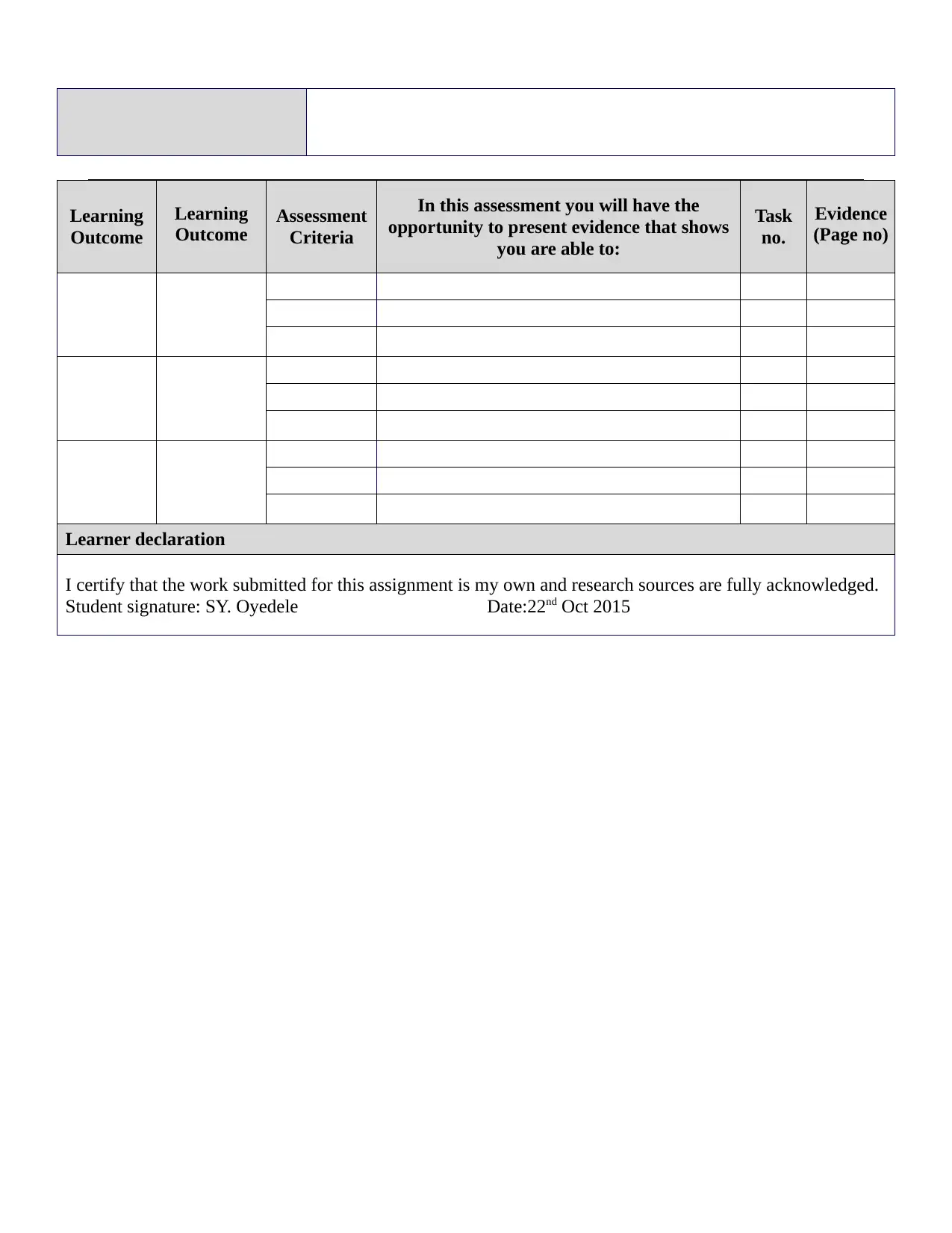
Learning
Outcome
Learning
Outcome Assessment
Criteria
In this assessment you will have the
opportunity to present evidence that shows
you are able to:
Task
no.
Evidence
(Page no)
Learner declaration
I certify that the work submitted for this assignment is my own and research sources are fully acknowledged.
Student signature: SY. Oyedele Date:22nd Oct 2015
Outcome
Learning
Outcome Assessment
Criteria
In this assessment you will have the
opportunity to present evidence that shows
you are able to:
Task
no.
Evidence
(Page no)
Learner declaration
I certify that the work submitted for this assignment is my own and research sources are fully acknowledged.
Student signature: SY. Oyedele Date:22nd Oct 2015
Secure Best Marks with AI Grader
Need help grading? Try our AI Grader for instant feedback on your assignments.

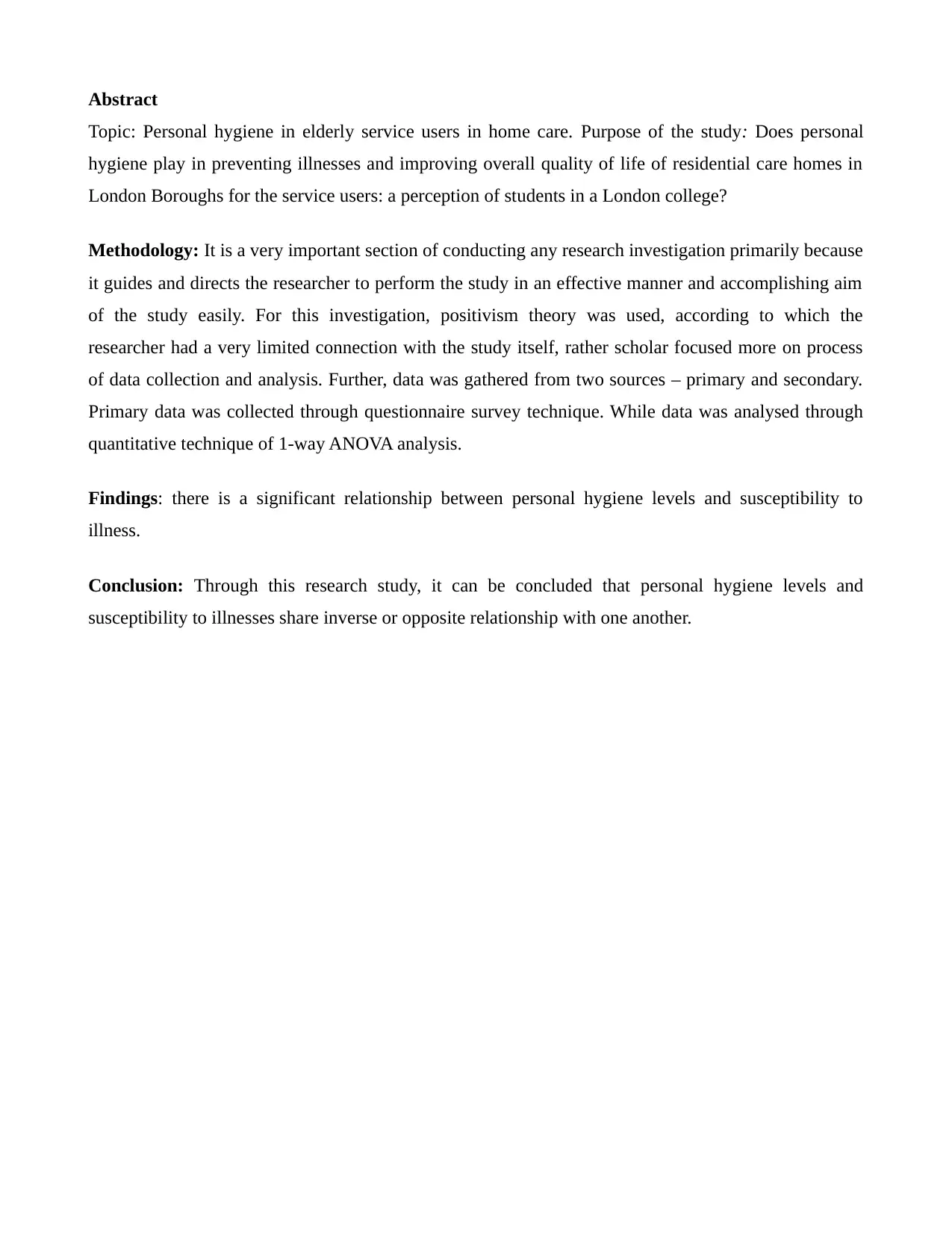
Abstract
Topic: Personal hygiene in elderly service users in home care. Purpose of the study: Does personal
hygiene play in preventing illnesses and improving overall quality of life of residential care homes in
London Boroughs for the service users: a perception of students in a London college?
Methodology: It is a very important section of conducting any research investigation primarily because
it guides and directs the researcher to perform the study in an effective manner and accomplishing aim
of the study easily. For this investigation, positivism theory was used, according to which the
researcher had a very limited connection with the study itself, rather scholar focused more on process
of data collection and analysis. Further, data was gathered from two sources – primary and secondary.
Primary data was collected through questionnaire survey technique. While data was analysed through
quantitative technique of 1-way ANOVA analysis.
Findings: there is a significant relationship between personal hygiene levels and susceptibility to
illness.
Conclusion: Through this research study, it can be concluded that personal hygiene levels and
susceptibility to illnesses share inverse or opposite relationship with one another.
Topic: Personal hygiene in elderly service users in home care. Purpose of the study: Does personal
hygiene play in preventing illnesses and improving overall quality of life of residential care homes in
London Boroughs for the service users: a perception of students in a London college?
Methodology: It is a very important section of conducting any research investigation primarily because
it guides and directs the researcher to perform the study in an effective manner and accomplishing aim
of the study easily. For this investigation, positivism theory was used, according to which the
researcher had a very limited connection with the study itself, rather scholar focused more on process
of data collection and analysis. Further, data was gathered from two sources – primary and secondary.
Primary data was collected through questionnaire survey technique. While data was analysed through
quantitative technique of 1-way ANOVA analysis.
Findings: there is a significant relationship between personal hygiene levels and susceptibility to
illness.
Conclusion: Through this research study, it can be concluded that personal hygiene levels and
susceptibility to illnesses share inverse or opposite relationship with one another.

Acknowledgement I would like
to express the deepest appreciation to my Lecturer who has the attitude and the substance of a genius:
he continually and convincingly conveyed a spirit of adventure in regard to research and an excitement
in regard to teaching. Without his guidance and persistent help this dissertation would not have been
possible. I also say a big thank you to my colleagues who participate to make the Research a success.
to express the deepest appreciation to my Lecturer who has the attitude and the substance of a genius:
he continually and convincingly conveyed a spirit of adventure in regard to research and an excitement
in regard to teaching. Without his guidance and persistent help this dissertation would not have been
possible. I also say a big thank you to my colleagues who participate to make the Research a success.
Secure Best Marks with AI Grader
Need help grading? Try our AI Grader for instant feedback on your assignments.
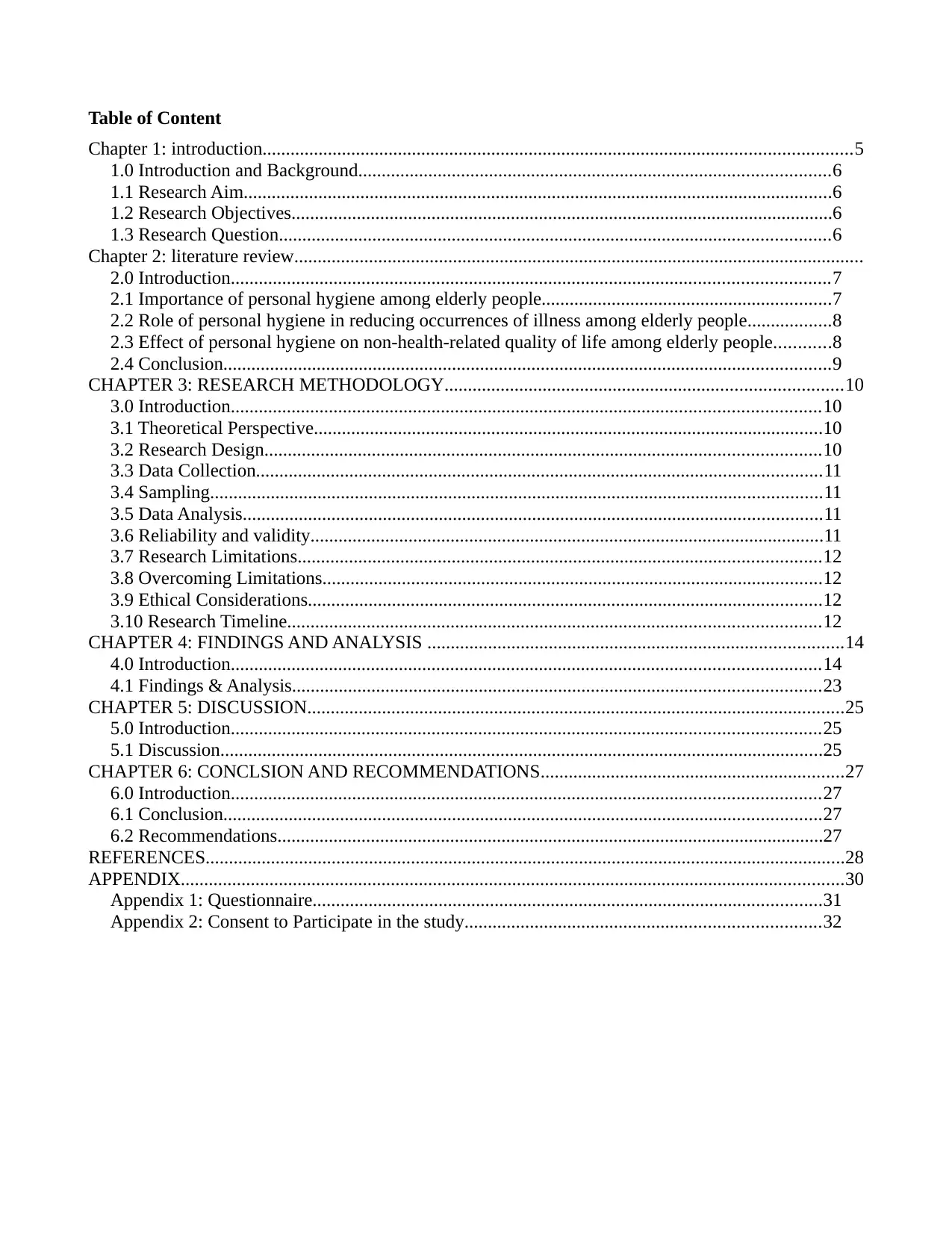
Table of Content
Chapter 1: introduction..............................................................................................................................5
1.0 Introduction and Background.....................................................................................................6
1.1 Research Aim..............................................................................................................................6
1.2 Research Objectives....................................................................................................................6
1.3 Research Question......................................................................................................................6
Chapter 2: literature review..........................................................................................................................
2.0 Introduction................................................................................................................................7
2.1 Importance of personal hygiene among elderly people..............................................................7
2.2 Role of personal hygiene in reducing occurrences of illness among elderly people..................8
2.3 Effect of personal hygiene on non-health-related quality of life among elderly people............8
2.4 Conclusion..................................................................................................................................9
CHAPTER 3: RESEARCH METHODOLOGY.....................................................................................10
3.0 Introduction..............................................................................................................................10
3.1 Theoretical Perspective.............................................................................................................10
3.2 Research Design.......................................................................................................................10
3.3 Data Collection.........................................................................................................................11
3.4 Sampling...................................................................................................................................11
3.5 Data Analysis............................................................................................................................11
3.6 Reliability and validity..............................................................................................................11
3.7 Research Limitations................................................................................................................12
3.8 Overcoming Limitations...........................................................................................................12
3.9 Ethical Considerations..............................................................................................................12
3.10 Research Timeline..................................................................................................................12
CHAPTER 4: FINDINGS AND ANALYSIS .........................................................................................14
4.0 Introduction..............................................................................................................................14
4.1 Findings & Analysis.................................................................................................................23
CHAPTER 5: DISCUSSION...................................................................................................................25
5.0 Introduction..............................................................................................................................25
5.1 Discussion.................................................................................................................................25
CHAPTER 6: CONCLSION AND RECOMMENDATIONS.................................................................27
6.0 Introduction..............................................................................................................................27
6.1 Conclusion................................................................................................................................27
6.2 Recommendations.....................................................................................................................27
REFERENCES.........................................................................................................................................28
APPENDIX..............................................................................................................................................30
Appendix 1: Questionnaire.............................................................................................................31
Appendix 2: Consent to Participate in the study............................................................................32
Chapter 1: introduction..............................................................................................................................5
1.0 Introduction and Background.....................................................................................................6
1.1 Research Aim..............................................................................................................................6
1.2 Research Objectives....................................................................................................................6
1.3 Research Question......................................................................................................................6
Chapter 2: literature review..........................................................................................................................
2.0 Introduction................................................................................................................................7
2.1 Importance of personal hygiene among elderly people..............................................................7
2.2 Role of personal hygiene in reducing occurrences of illness among elderly people..................8
2.3 Effect of personal hygiene on non-health-related quality of life among elderly people............8
2.4 Conclusion..................................................................................................................................9
CHAPTER 3: RESEARCH METHODOLOGY.....................................................................................10
3.0 Introduction..............................................................................................................................10
3.1 Theoretical Perspective.............................................................................................................10
3.2 Research Design.......................................................................................................................10
3.3 Data Collection.........................................................................................................................11
3.4 Sampling...................................................................................................................................11
3.5 Data Analysis............................................................................................................................11
3.6 Reliability and validity..............................................................................................................11
3.7 Research Limitations................................................................................................................12
3.8 Overcoming Limitations...........................................................................................................12
3.9 Ethical Considerations..............................................................................................................12
3.10 Research Timeline..................................................................................................................12
CHAPTER 4: FINDINGS AND ANALYSIS .........................................................................................14
4.0 Introduction..............................................................................................................................14
4.1 Findings & Analysis.................................................................................................................23
CHAPTER 5: DISCUSSION...................................................................................................................25
5.0 Introduction..............................................................................................................................25
5.1 Discussion.................................................................................................................................25
CHAPTER 6: CONCLSION AND RECOMMENDATIONS.................................................................27
6.0 Introduction..............................................................................................................................27
6.1 Conclusion................................................................................................................................27
6.2 Recommendations.....................................................................................................................27
REFERENCES.........................................................................................................................................28
APPENDIX..............................................................................................................................................30
Appendix 1: Questionnaire.............................................................................................................31
Appendix 2: Consent to Participate in the study............................................................................32
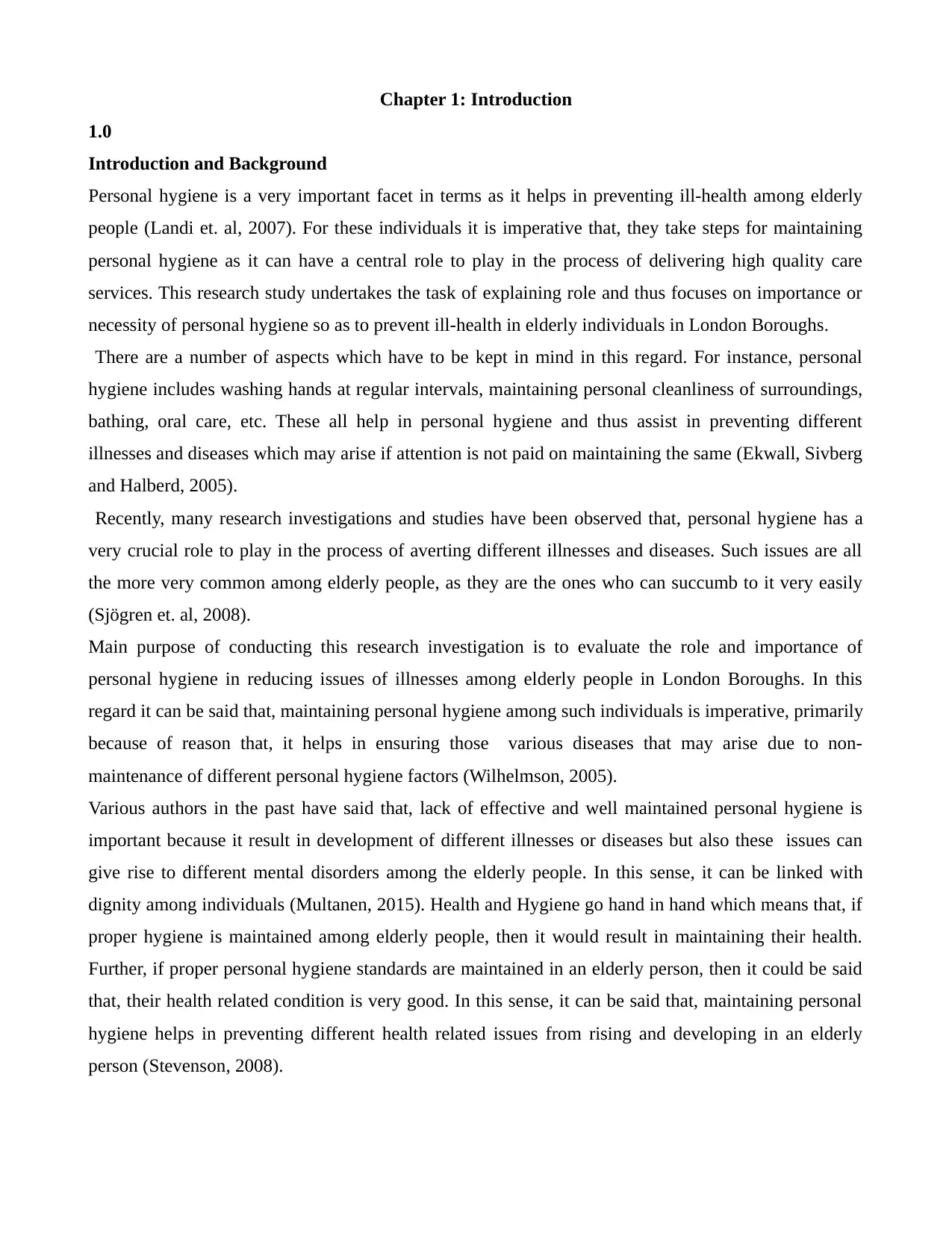
Chapter 1: Introduction
1.0
Introduction and Background
Personal hygiene is a very important facet in terms as it helps in preventing ill-health among elderly
people (Landi et. al, 2007). For these individuals it is imperative that, they take steps for maintaining
personal hygiene as it can have a central role to play in the process of delivering high quality care
services. This research study undertakes the task of explaining role and thus focuses on importance or
necessity of personal hygiene so as to prevent ill-health in elderly individuals in London Boroughs.
There are a number of aspects which have to be kept in mind in this regard. For instance, personal
hygiene includes washing hands at regular intervals, maintaining personal cleanliness of surroundings,
bathing, oral care, etc. These all help in personal hygiene and thus assist in preventing different
illnesses and diseases which may arise if attention is not paid on maintaining the same (Ekwall, Sivberg
and Halberd, 2005).
Recently, many research investigations and studies have been observed that, personal hygiene has a
very crucial role to play in the process of averting different illnesses and diseases. Such issues are all
the more very common among elderly people, as they are the ones who can succumb to it very easily
(Sjögren et. al, 2008).
Main purpose of conducting this research investigation is to evaluate the role and importance of
personal hygiene in reducing issues of illnesses among elderly people in London Boroughs. In this
regard it can be said that, maintaining personal hygiene among such individuals is imperative, primarily
because of reason that, it helps in ensuring those various diseases that may arise due to non-
maintenance of different personal hygiene factors (Wilhelmson, 2005).
Various authors in the past have said that, lack of effective and well maintained personal hygiene is
important because it result in development of different illnesses or diseases but also these issues can
give rise to different mental disorders among the elderly people. In this sense, it can be linked with
dignity among individuals (Multanen, 2015). Health and Hygiene go hand in hand which means that, if
proper hygiene is maintained among elderly people, then it would result in maintaining their health.
Further, if proper personal hygiene standards are maintained in an elderly person, then it could be said
that, their health related condition is very good. In this sense, it can be said that, maintaining personal
hygiene helps in preventing different health related issues from rising and developing in an elderly
person (Stevenson, 2008).
1.0
Introduction and Background
Personal hygiene is a very important facet in terms as it helps in preventing ill-health among elderly
people (Landi et. al, 2007). For these individuals it is imperative that, they take steps for maintaining
personal hygiene as it can have a central role to play in the process of delivering high quality care
services. This research study undertakes the task of explaining role and thus focuses on importance or
necessity of personal hygiene so as to prevent ill-health in elderly individuals in London Boroughs.
There are a number of aspects which have to be kept in mind in this regard. For instance, personal
hygiene includes washing hands at regular intervals, maintaining personal cleanliness of surroundings,
bathing, oral care, etc. These all help in personal hygiene and thus assist in preventing different
illnesses and diseases which may arise if attention is not paid on maintaining the same (Ekwall, Sivberg
and Halberd, 2005).
Recently, many research investigations and studies have been observed that, personal hygiene has a
very crucial role to play in the process of averting different illnesses and diseases. Such issues are all
the more very common among elderly people, as they are the ones who can succumb to it very easily
(Sjögren et. al, 2008).
Main purpose of conducting this research investigation is to evaluate the role and importance of
personal hygiene in reducing issues of illnesses among elderly people in London Boroughs. In this
regard it can be said that, maintaining personal hygiene among such individuals is imperative, primarily
because of reason that, it helps in ensuring those various diseases that may arise due to non-
maintenance of different personal hygiene factors (Wilhelmson, 2005).
Various authors in the past have said that, lack of effective and well maintained personal hygiene is
important because it result in development of different illnesses or diseases but also these issues can
give rise to different mental disorders among the elderly people. In this sense, it can be linked with
dignity among individuals (Multanen, 2015). Health and Hygiene go hand in hand which means that, if
proper hygiene is maintained among elderly people, then it would result in maintaining their health.
Further, if proper personal hygiene standards are maintained in an elderly person, then it could be said
that, their health related condition is very good. In this sense, it can be said that, maintaining personal
hygiene helps in preventing different health related issues from rising and developing in an elderly
person (Stevenson, 2008).
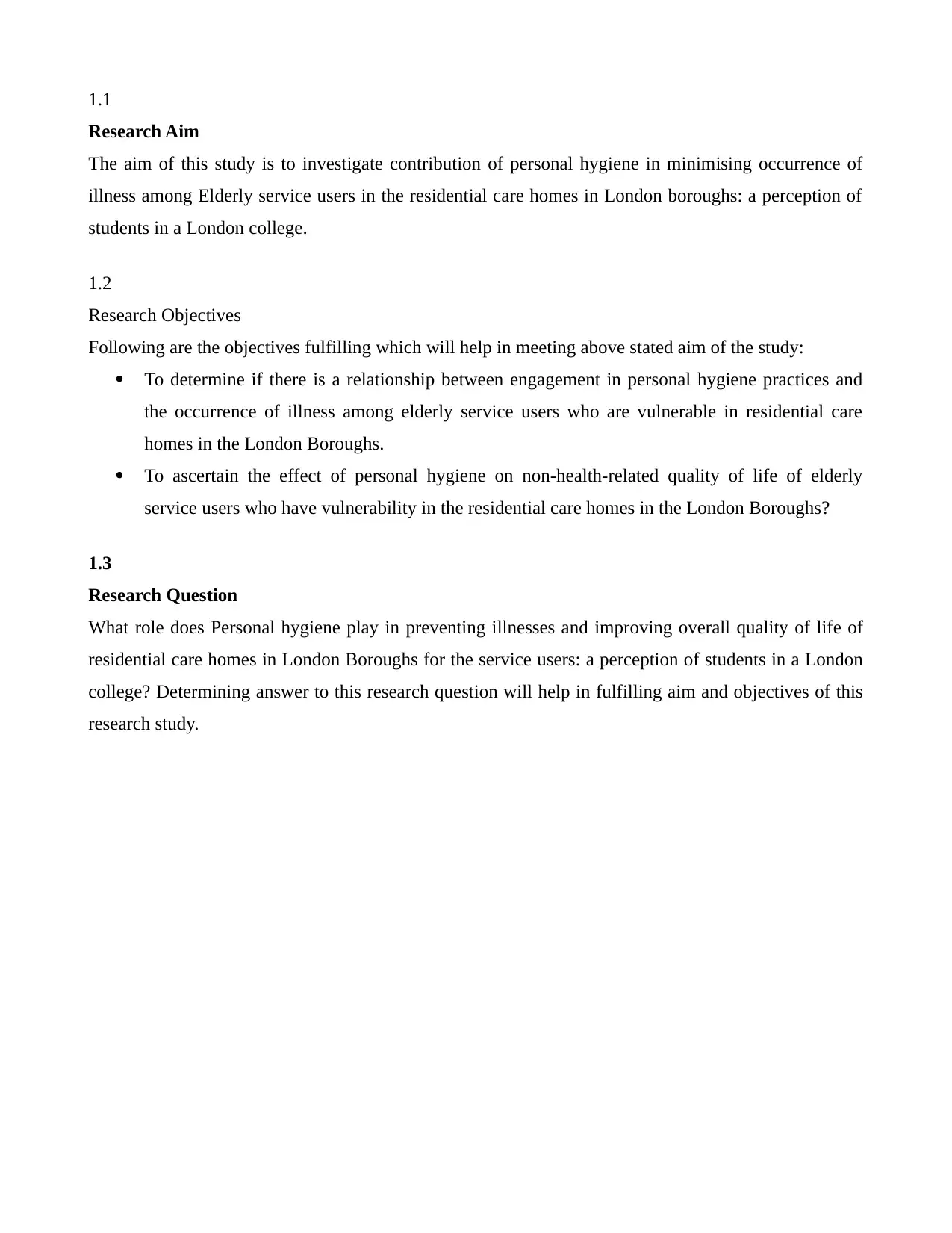
1.1
Research Aim
The aim of this study is to investigate contribution of personal hygiene in minimising occurrence of
illness among Elderly service users in the residential care homes in London boroughs: a perception of
students in a London college.
1.2
Research Objectives
Following are the objectives fulfilling which will help in meeting above stated aim of the study:
To determine if there is a relationship between engagement in personal hygiene practices and
the occurrence of illness among elderly service users who are vulnerable in residential care
homes in the London Boroughs.
To ascertain the effect of personal hygiene on non-health-related quality of life of elderly
service users who have vulnerability in the residential care homes in the London Boroughs?
1.3
Research Question
What role does Personal hygiene play in preventing illnesses and improving overall quality of life of
residential care homes in London Boroughs for the service users: a perception of students in a London
college? Determining answer to this research question will help in fulfilling aim and objectives of this
research study.
Research Aim
The aim of this study is to investigate contribution of personal hygiene in minimising occurrence of
illness among Elderly service users in the residential care homes in London boroughs: a perception of
students in a London college.
1.2
Research Objectives
Following are the objectives fulfilling which will help in meeting above stated aim of the study:
To determine if there is a relationship between engagement in personal hygiene practices and
the occurrence of illness among elderly service users who are vulnerable in residential care
homes in the London Boroughs.
To ascertain the effect of personal hygiene on non-health-related quality of life of elderly
service users who have vulnerability in the residential care homes in the London Boroughs?
1.3
Research Question
What role does Personal hygiene play in preventing illnesses and improving overall quality of life of
residential care homes in London Boroughs for the service users: a perception of students in a London
college? Determining answer to this research question will help in fulfilling aim and objectives of this
research study.
Paraphrase This Document
Need a fresh take? Get an instant paraphrase of this document with our AI Paraphraser
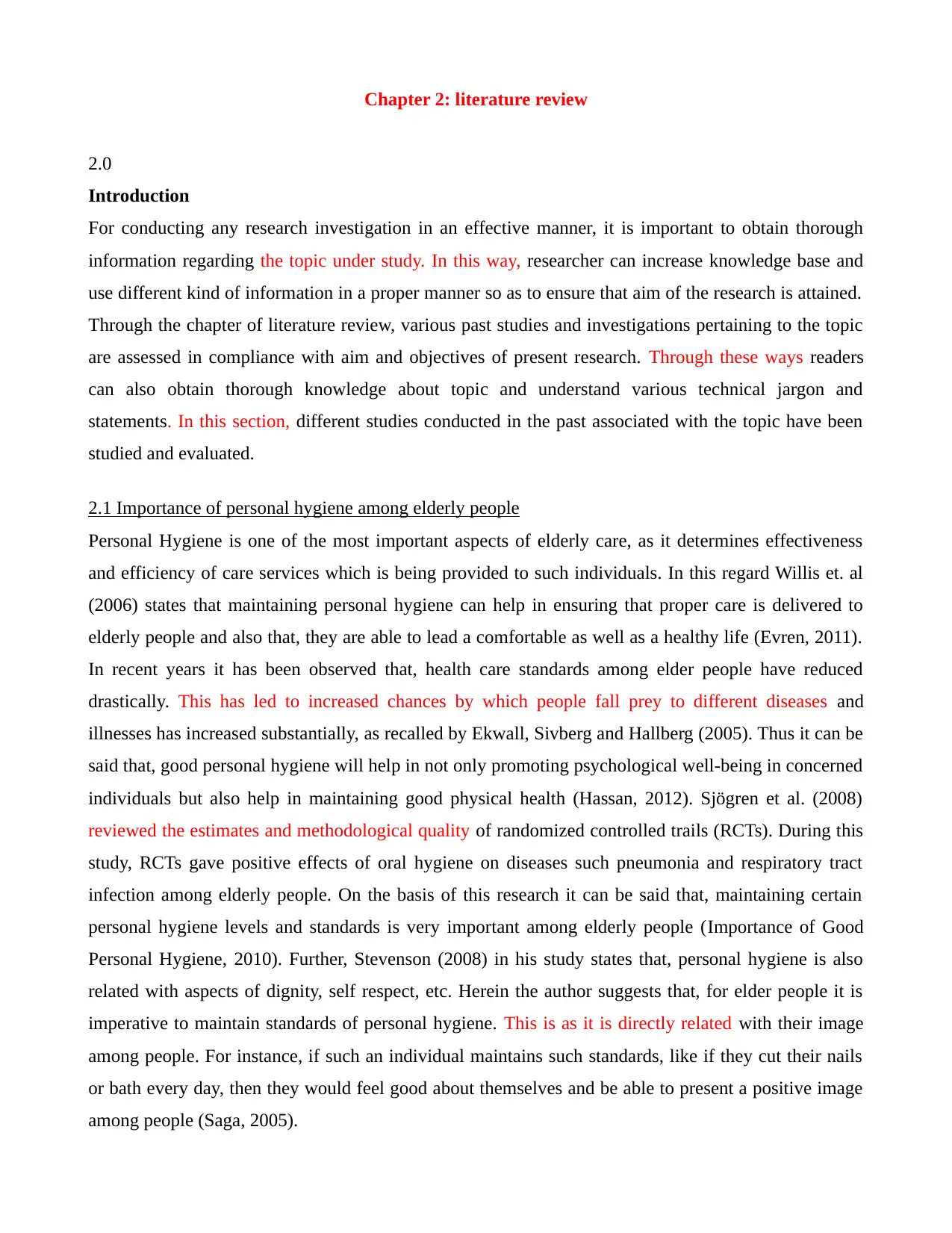
Chapter 2: literature review
2.0
Introduction
For conducting any research investigation in an effective manner, it is important to obtain thorough
information regarding the topic under study. In this way, researcher can increase knowledge base and
use different kind of information in a proper manner so as to ensure that aim of the research is attained.
Through the chapter of literature review, various past studies and investigations pertaining to the topic
are assessed in compliance with aim and objectives of present research. Through these ways readers
can also obtain thorough knowledge about topic and understand various technical jargon and
statements. In this section, different studies conducted in the past associated with the topic have been
studied and evaluated.
2.1 Importance of personal hygiene among elderly people
Personal Hygiene is one of the most important aspects of elderly care, as it determines effectiveness
and efficiency of care services which is being provided to such individuals. In this regard Willis et. al
(2006) states that maintaining personal hygiene can help in ensuring that proper care is delivered to
elderly people and also that, they are able to lead a comfortable as well as a healthy life (Evren, 2011).
In recent years it has been observed that, health care standards among elder people have reduced
drastically. This has led to increased chances by which people fall prey to different diseases and
illnesses has increased substantially, as recalled by Ekwall, Sivberg and Hallberg (2005). Thus it can be
said that, good personal hygiene will help in not only promoting psychological well-being in concerned
individuals but also help in maintaining good physical health (Hassan, 2012). Sjögren et al. (2008)
reviewed the estimates and methodological quality of randomized controlled trails (RCTs). During this
study, RCTs gave positive effects of oral hygiene on diseases such pneumonia and respiratory tract
infection among elderly people. On the basis of this research it can be said that, maintaining certain
personal hygiene levels and standards is very important among elderly people (Importance of Good
Personal Hygiene, 2010). Further, Stevenson (2008) in his study states that, personal hygiene is also
related with aspects of dignity, self respect, etc. Herein the author suggests that, for elder people it is
imperative to maintain standards of personal hygiene. This is as it is directly related with their image
among people. For instance, if such an individual maintains such standards, like if they cut their nails
or bath every day, then they would feel good about themselves and be able to present a positive image
among people (Saga, 2005).
2.0
Introduction
For conducting any research investigation in an effective manner, it is important to obtain thorough
information regarding the topic under study. In this way, researcher can increase knowledge base and
use different kind of information in a proper manner so as to ensure that aim of the research is attained.
Through the chapter of literature review, various past studies and investigations pertaining to the topic
are assessed in compliance with aim and objectives of present research. Through these ways readers
can also obtain thorough knowledge about topic and understand various technical jargon and
statements. In this section, different studies conducted in the past associated with the topic have been
studied and evaluated.
2.1 Importance of personal hygiene among elderly people
Personal Hygiene is one of the most important aspects of elderly care, as it determines effectiveness
and efficiency of care services which is being provided to such individuals. In this regard Willis et. al
(2006) states that maintaining personal hygiene can help in ensuring that proper care is delivered to
elderly people and also that, they are able to lead a comfortable as well as a healthy life (Evren, 2011).
In recent years it has been observed that, health care standards among elder people have reduced
drastically. This has led to increased chances by which people fall prey to different diseases and
illnesses has increased substantially, as recalled by Ekwall, Sivberg and Hallberg (2005). Thus it can be
said that, good personal hygiene will help in not only promoting psychological well-being in concerned
individuals but also help in maintaining good physical health (Hassan, 2012). Sjögren et al. (2008)
reviewed the estimates and methodological quality of randomized controlled trails (RCTs). During this
study, RCTs gave positive effects of oral hygiene on diseases such pneumonia and respiratory tract
infection among elderly people. On the basis of this research it can be said that, maintaining certain
personal hygiene levels and standards is very important among elderly people (Importance of Good
Personal Hygiene, 2010). Further, Stevenson (2008) in his study states that, personal hygiene is also
related with aspects of dignity, self respect, etc. Herein the author suggests that, for elder people it is
imperative to maintain standards of personal hygiene. This is as it is directly related with their image
among people. For instance, if such an individual maintains such standards, like if they cut their nails
or bath every day, then they would feel good about themselves and be able to present a positive image
among people (Saga, 2005).
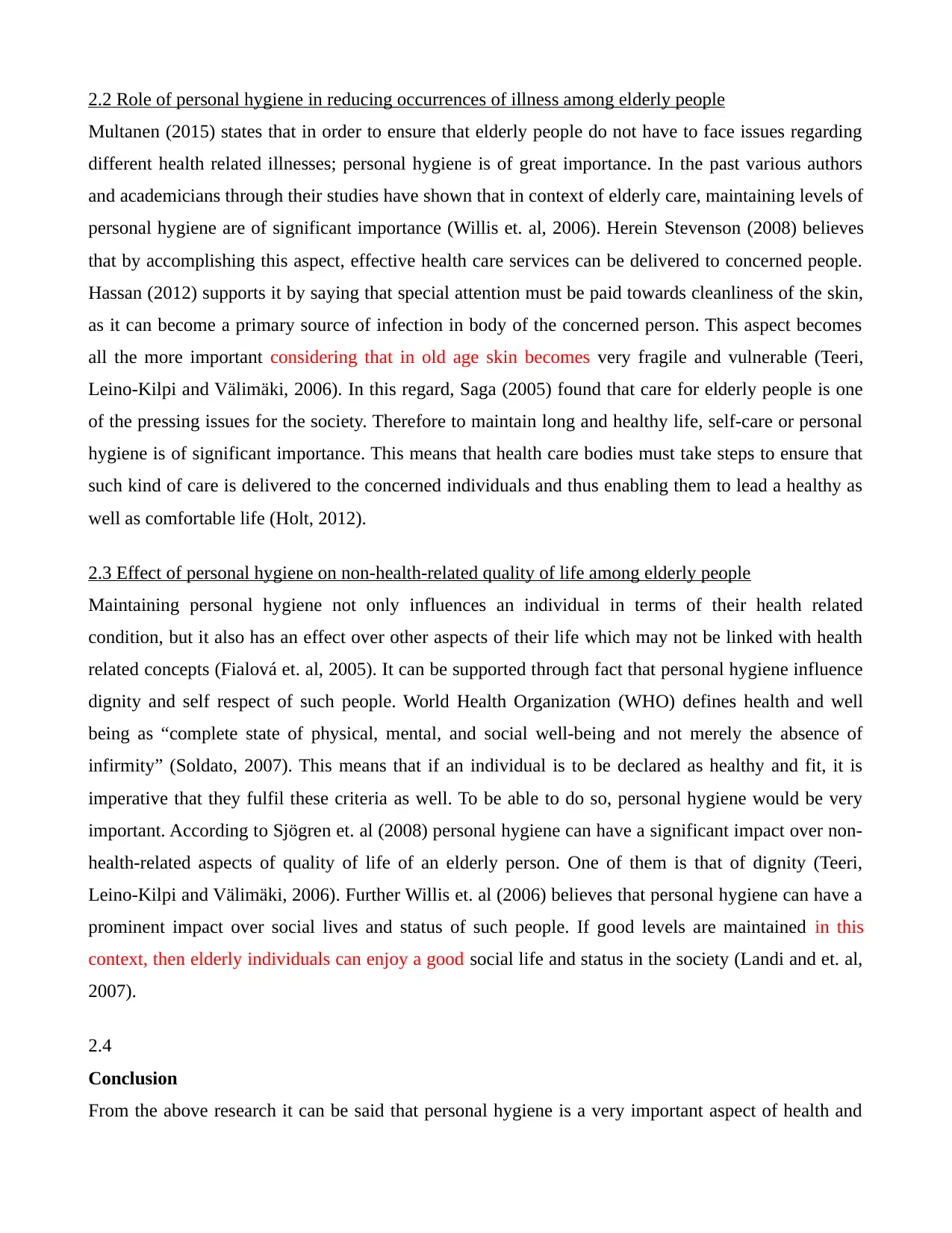
2.2 Role of personal hygiene in reducing occurrences of illness among elderly people
Multanen (2015) states that in order to ensure that elderly people do not have to face issues regarding
different health related illnesses; personal hygiene is of great importance. In the past various authors
and academicians through their studies have shown that in context of elderly care, maintaining levels of
personal hygiene are of significant importance (Willis et. al, 2006). Herein Stevenson (2008) believes
that by accomplishing this aspect, effective health care services can be delivered to concerned people.
Hassan (2012) supports it by saying that special attention must be paid towards cleanliness of the skin,
as it can become a primary source of infection in body of the concerned person. This aspect becomes
all the more important considering that in old age skin becomes very fragile and vulnerable (Teeri,
Leino-Kilpi and Välimäki, 2006). In this regard, Saga (2005) found that care for elderly people is one
of the pressing issues for the society. Therefore to maintain long and healthy life, self-care or personal
hygiene is of significant importance. This means that health care bodies must take steps to ensure that
such kind of care is delivered to the concerned individuals and thus enabling them to lead a healthy as
well as comfortable life (Holt, 2012).
2.3 Effect of personal hygiene on non-health-related quality of life among elderly people
Maintaining personal hygiene not only influences an individual in terms of their health related
condition, but it also has an effect over other aspects of their life which may not be linked with health
related concepts (Fialová et. al, 2005). It can be supported through fact that personal hygiene influence
dignity and self respect of such people. World Health Organization (WHO) defines health and well
being as “complete state of physical, mental, and social well-being and not merely the absence of
infirmity” (Soldato, 2007). This means that if an individual is to be declared as healthy and fit, it is
imperative that they fulfil these criteria as well. To be able to do so, personal hygiene would be very
important. According to Sjögren et. al (2008) personal hygiene can have a significant impact over non-
health-related aspects of quality of life of an elderly person. One of them is that of dignity (Teeri,
Leino-Kilpi and Välimäki, 2006). Further Willis et. al (2006) believes that personal hygiene can have a
prominent impact over social lives and status of such people. If good levels are maintained in this
context, then elderly individuals can enjoy a good social life and status in the society (Landi and et. al,
2007).
2.4
Conclusion
From the above research it can be said that personal hygiene is a very important aspect of health and
Multanen (2015) states that in order to ensure that elderly people do not have to face issues regarding
different health related illnesses; personal hygiene is of great importance. In the past various authors
and academicians through their studies have shown that in context of elderly care, maintaining levels of
personal hygiene are of significant importance (Willis et. al, 2006). Herein Stevenson (2008) believes
that by accomplishing this aspect, effective health care services can be delivered to concerned people.
Hassan (2012) supports it by saying that special attention must be paid towards cleanliness of the skin,
as it can become a primary source of infection in body of the concerned person. This aspect becomes
all the more important considering that in old age skin becomes very fragile and vulnerable (Teeri,
Leino-Kilpi and Välimäki, 2006). In this regard, Saga (2005) found that care for elderly people is one
of the pressing issues for the society. Therefore to maintain long and healthy life, self-care or personal
hygiene is of significant importance. This means that health care bodies must take steps to ensure that
such kind of care is delivered to the concerned individuals and thus enabling them to lead a healthy as
well as comfortable life (Holt, 2012).
2.3 Effect of personal hygiene on non-health-related quality of life among elderly people
Maintaining personal hygiene not only influences an individual in terms of their health related
condition, but it also has an effect over other aspects of their life which may not be linked with health
related concepts (Fialová et. al, 2005). It can be supported through fact that personal hygiene influence
dignity and self respect of such people. World Health Organization (WHO) defines health and well
being as “complete state of physical, mental, and social well-being and not merely the absence of
infirmity” (Soldato, 2007). This means that if an individual is to be declared as healthy and fit, it is
imperative that they fulfil these criteria as well. To be able to do so, personal hygiene would be very
important. According to Sjögren et. al (2008) personal hygiene can have a significant impact over non-
health-related aspects of quality of life of an elderly person. One of them is that of dignity (Teeri,
Leino-Kilpi and Välimäki, 2006). Further Willis et. al (2006) believes that personal hygiene can have a
prominent impact over social lives and status of such people. If good levels are maintained in this
context, then elderly individuals can enjoy a good social life and status in the society (Landi and et. al,
2007).
2.4
Conclusion
From the above research it can be said that personal hygiene is a very important aspect of health and

social care for elderly people. During the study it was observed that maintaining personal hygiene
levels can help in improving dignity and self-respect levels in such individuals. Furthermore, personal
hygiene levels help in reducing occurrences of illness among elderly people and the way they lead their
lives. In addition to it, personal hygiene can influence social status and lives of elderly people.
levels can help in improving dignity and self-respect levels in such individuals. Furthermore, personal
hygiene levels help in reducing occurrences of illness among elderly people and the way they lead their
lives. In addition to it, personal hygiene can influence social status and lives of elderly people.
Secure Best Marks with AI Grader
Need help grading? Try our AI Grader for instant feedback on your assignments.
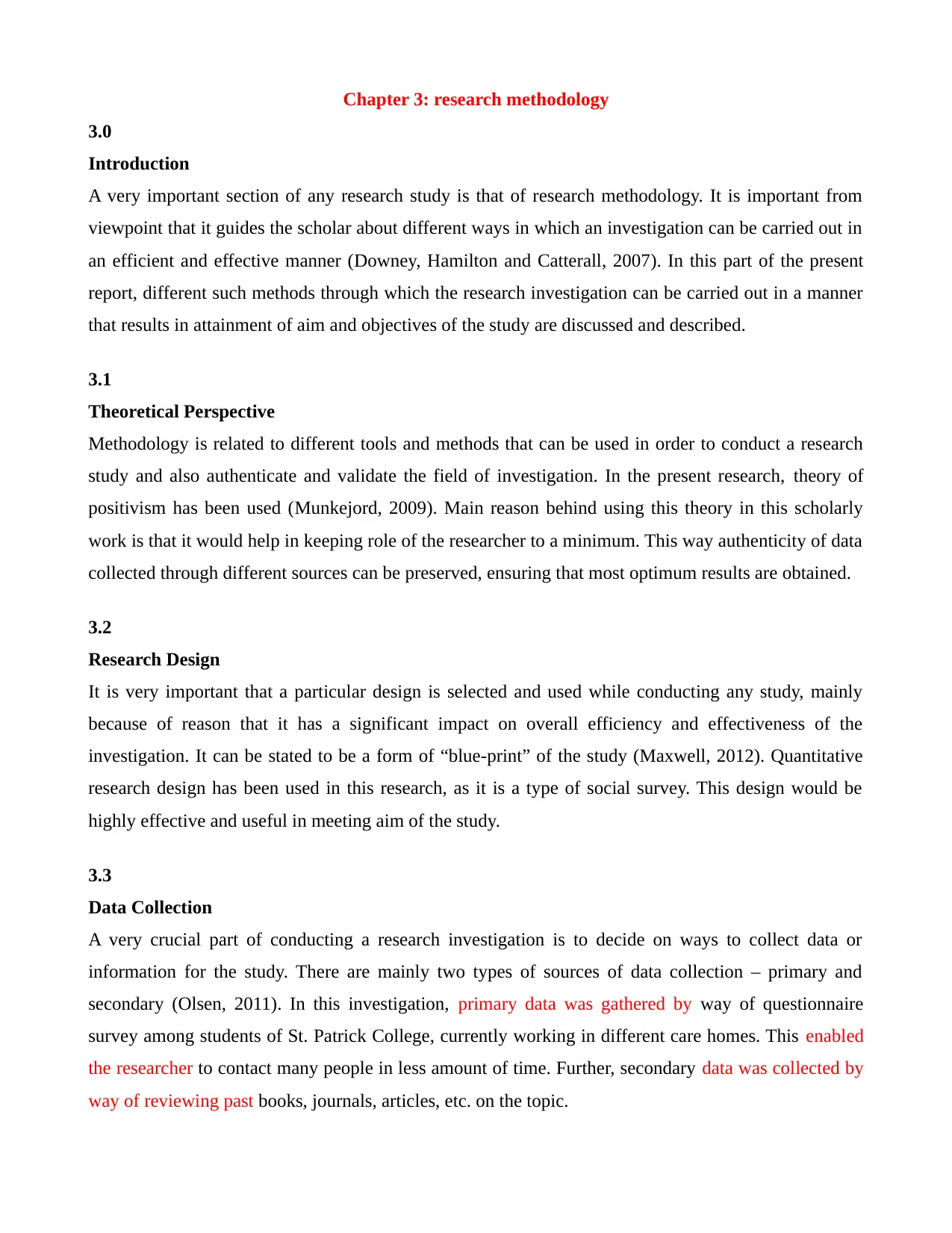
Chapter 3: research methodology
3.0
Introduction
A very important section of any research study is that of research methodology. It is important from
viewpoint that it guides the scholar about different ways in which an investigation can be carried out in
an efficient and effective manner (Downey, Hamilton and Catterall, 2007). In this part of the present
report, different such methods through which the research investigation can be carried out in a manner
that results in attainment of aim and objectives of the study are discussed and described.
3.1
Theoretical Perspective
Methodology is related to different tools and methods that can be used in order to conduct a research
study and also authenticate and validate the field of investigation. In the present research, theory of
positivism has been used (Munkejord, 2009). Main reason behind using this theory in this scholarly
work is that it would help in keeping role of the researcher to a minimum. This way authenticity of data
collected through different sources can be preserved, ensuring that most optimum results are obtained.
3.2
Research Design
It is very important that a particular design is selected and used while conducting any study, mainly
because of reason that it has a significant impact on overall efficiency and effectiveness of the
investigation. It can be stated to be a form of “blue-print” of the study (Maxwell, 2012). Quantitative
research design has been used in this research, as it is a type of social survey. This design would be
highly effective and useful in meeting aim of the study.
3.3
Data Collection
A very crucial part of conducting a research investigation is to decide on ways to collect data or
information for the study. There are mainly two types of sources of data collection – primary and
secondary (Olsen, 2011). In this investigation, primary data was gathered by way of questionnaire
survey among students of St. Patrick College, currently working in different care homes. This enabled
the researcher to contact many people in less amount of time. Further, secondary data was collected by
way of reviewing past books, journals, articles, etc. on the topic.
3.0
Introduction
A very important section of any research study is that of research methodology. It is important from
viewpoint that it guides the scholar about different ways in which an investigation can be carried out in
an efficient and effective manner (Downey, Hamilton and Catterall, 2007). In this part of the present
report, different such methods through which the research investigation can be carried out in a manner
that results in attainment of aim and objectives of the study are discussed and described.
3.1
Theoretical Perspective
Methodology is related to different tools and methods that can be used in order to conduct a research
study and also authenticate and validate the field of investigation. In the present research, theory of
positivism has been used (Munkejord, 2009). Main reason behind using this theory in this scholarly
work is that it would help in keeping role of the researcher to a minimum. This way authenticity of data
collected through different sources can be preserved, ensuring that most optimum results are obtained.
3.2
Research Design
It is very important that a particular design is selected and used while conducting any study, mainly
because of reason that it has a significant impact on overall efficiency and effectiveness of the
investigation. It can be stated to be a form of “blue-print” of the study (Maxwell, 2012). Quantitative
research design has been used in this research, as it is a type of social survey. This design would be
highly effective and useful in meeting aim of the study.
3.3
Data Collection
A very crucial part of conducting a research investigation is to decide on ways to collect data or
information for the study. There are mainly two types of sources of data collection – primary and
secondary (Olsen, 2011). In this investigation, primary data was gathered by way of questionnaire
survey among students of St. Patrick College, currently working in different care homes. This enabled
the researcher to contact many people in less amount of time. Further, secondary data was collected by
way of reviewing past books, journals, articles, etc. on the topic.
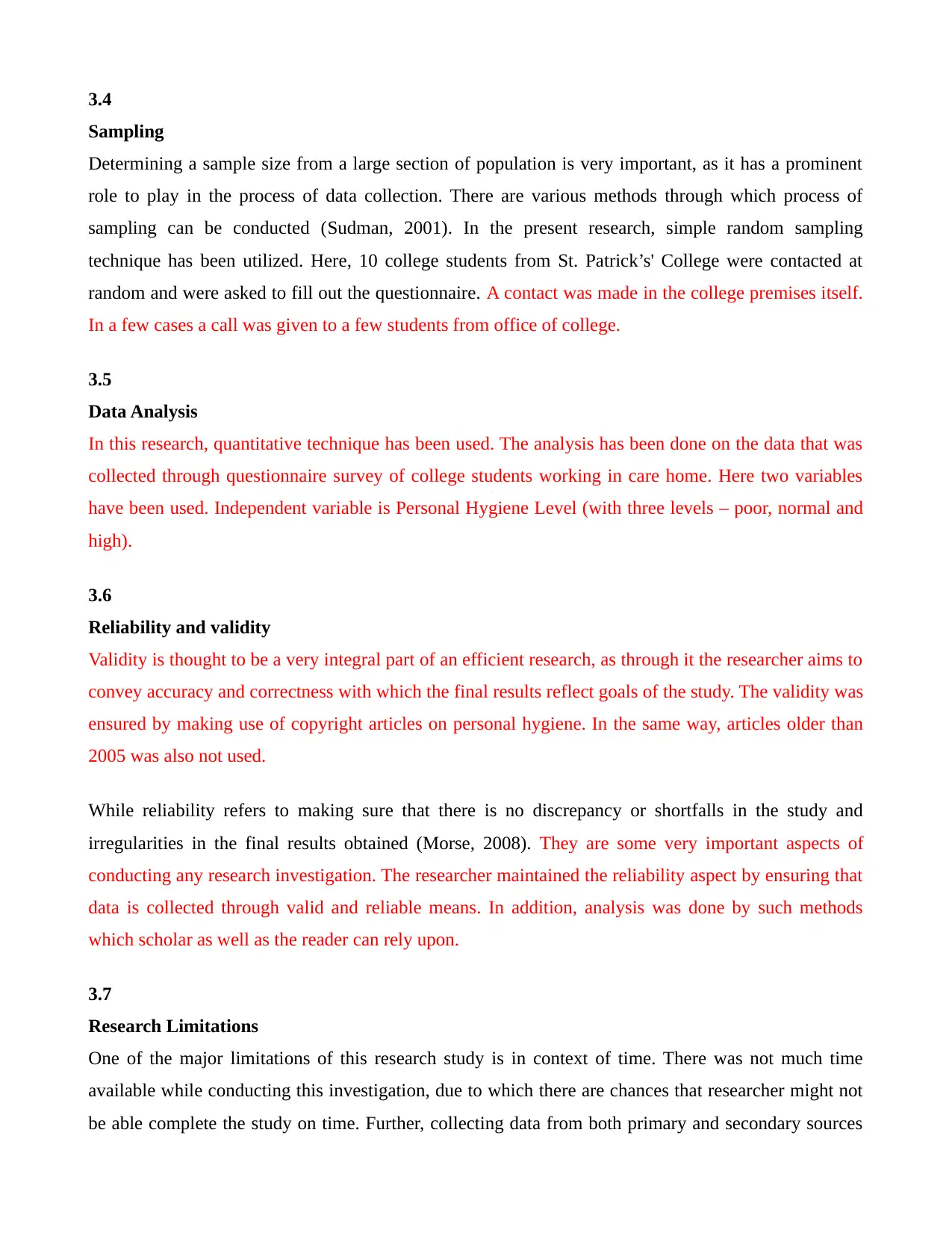
3.4
Sampling
Determining a sample size from a large section of population is very important, as it has a prominent
role to play in the process of data collection. There are various methods through which process of
sampling can be conducted (Sudman, 2001). In the present research, simple random sampling
technique has been utilized. Here, 10 college students from St. Patrick’s' College were contacted at
random and were asked to fill out the questionnaire. A contact was made in the college premises itself.
In a few cases a call was given to a few students from office of college.
3.5
Data Analysis
In this research, quantitative technique has been used. The analysis has been done on the data that was
collected through questionnaire survey of college students working in care home. Here two variables
have been used. Independent variable is Personal Hygiene Level (with three levels – poor, normal and
high).
3.6
Reliability and validity
Validity is thought to be a very integral part of an efficient research, as through it the researcher aims to
convey accuracy and correctness with which the final results reflect goals of the study. The validity was
ensured by making use of copyright articles on personal hygiene. In the same way, articles older than
2005 was also not used.
While reliability refers to making sure that there is no discrepancy or shortfalls in the study and
irregularities in the final results obtained (Morse, 2008). They are some very important aspects of
conducting any research investigation. The researcher maintained the reliability aspect by ensuring that
data is collected through valid and reliable means. In addition, analysis was done by such methods
which scholar as well as the reader can rely upon.
3.7
Research Limitations
One of the major limitations of this research study is in context of time. There was not much time
available while conducting this investigation, due to which there are chances that researcher might not
be able complete the study on time. Further, collecting data from both primary and secondary sources
Sampling
Determining a sample size from a large section of population is very important, as it has a prominent
role to play in the process of data collection. There are various methods through which process of
sampling can be conducted (Sudman, 2001). In the present research, simple random sampling
technique has been utilized. Here, 10 college students from St. Patrick’s' College were contacted at
random and were asked to fill out the questionnaire. A contact was made in the college premises itself.
In a few cases a call was given to a few students from office of college.
3.5
Data Analysis
In this research, quantitative technique has been used. The analysis has been done on the data that was
collected through questionnaire survey of college students working in care home. Here two variables
have been used. Independent variable is Personal Hygiene Level (with three levels – poor, normal and
high).
3.6
Reliability and validity
Validity is thought to be a very integral part of an efficient research, as through it the researcher aims to
convey accuracy and correctness with which the final results reflect goals of the study. The validity was
ensured by making use of copyright articles on personal hygiene. In the same way, articles older than
2005 was also not used.
While reliability refers to making sure that there is no discrepancy or shortfalls in the study and
irregularities in the final results obtained (Morse, 2008). They are some very important aspects of
conducting any research investigation. The researcher maintained the reliability aspect by ensuring that
data is collected through valid and reliable means. In addition, analysis was done by such methods
which scholar as well as the reader can rely upon.
3.7
Research Limitations
One of the major limitations of this research study is in context of time. There was not much time
available while conducting this investigation, due to which there are chances that researcher might not
be able complete the study on time. Further, collecting data from both primary and secondary sources
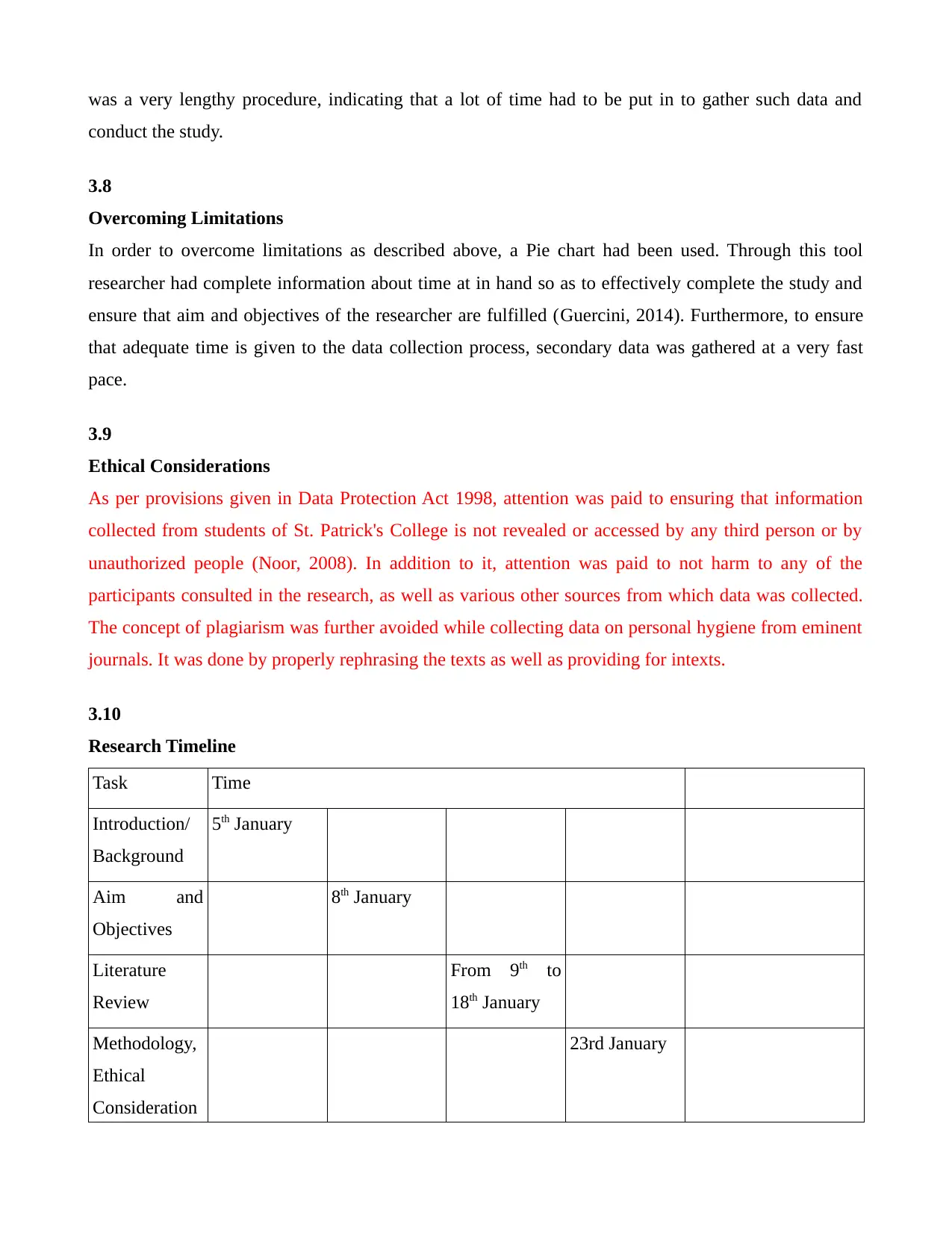
was a very lengthy procedure, indicating that a lot of time had to be put in to gather such data and
conduct the study.
3.8
Overcoming Limitations
In order to overcome limitations as described above, a Pie chart had been used. Through this tool
researcher had complete information about time at in hand so as to effectively complete the study and
ensure that aim and objectives of the researcher are fulfilled (Guercini, 2014). Furthermore, to ensure
that adequate time is given to the data collection process, secondary data was gathered at a very fast
pace.
3.9
Ethical Considerations
As per provisions given in Data Protection Act 1998, attention was paid to ensuring that information
collected from students of St. Patrick's College is not revealed or accessed by any third person or by
unauthorized people (Noor, 2008). In addition to it, attention was paid to not harm to any of the
participants consulted in the research, as well as various other sources from which data was collected.
The concept of plagiarism was further avoided while collecting data on personal hygiene from eminent
journals. It was done by properly rephrasing the texts as well as providing for intexts.
3.10
Research Timeline
Task Time
Introduction/
Background
5th January
Aim and
Objectives
8th January
Literature
Review
From 9th to
18th January
Methodology,
Ethical
Consideration
23rd January
conduct the study.
3.8
Overcoming Limitations
In order to overcome limitations as described above, a Pie chart had been used. Through this tool
researcher had complete information about time at in hand so as to effectively complete the study and
ensure that aim and objectives of the researcher are fulfilled (Guercini, 2014). Furthermore, to ensure
that adequate time is given to the data collection process, secondary data was gathered at a very fast
pace.
3.9
Ethical Considerations
As per provisions given in Data Protection Act 1998, attention was paid to ensuring that information
collected from students of St. Patrick's College is not revealed or accessed by any third person or by
unauthorized people (Noor, 2008). In addition to it, attention was paid to not harm to any of the
participants consulted in the research, as well as various other sources from which data was collected.
The concept of plagiarism was further avoided while collecting data on personal hygiene from eminent
journals. It was done by properly rephrasing the texts as well as providing for intexts.
3.10
Research Timeline
Task Time
Introduction/
Background
5th January
Aim and
Objectives
8th January
Literature
Review
From 9th to
18th January
Methodology,
Ethical
Consideration
23rd January
Paraphrase This Document
Need a fresh take? Get an instant paraphrase of this document with our AI Paraphraser

and Study
Limitations
Design
Questionnaire
and filling
consent letter
28th February
Limitations
Design
Questionnaire
and filling
consent letter
28th February
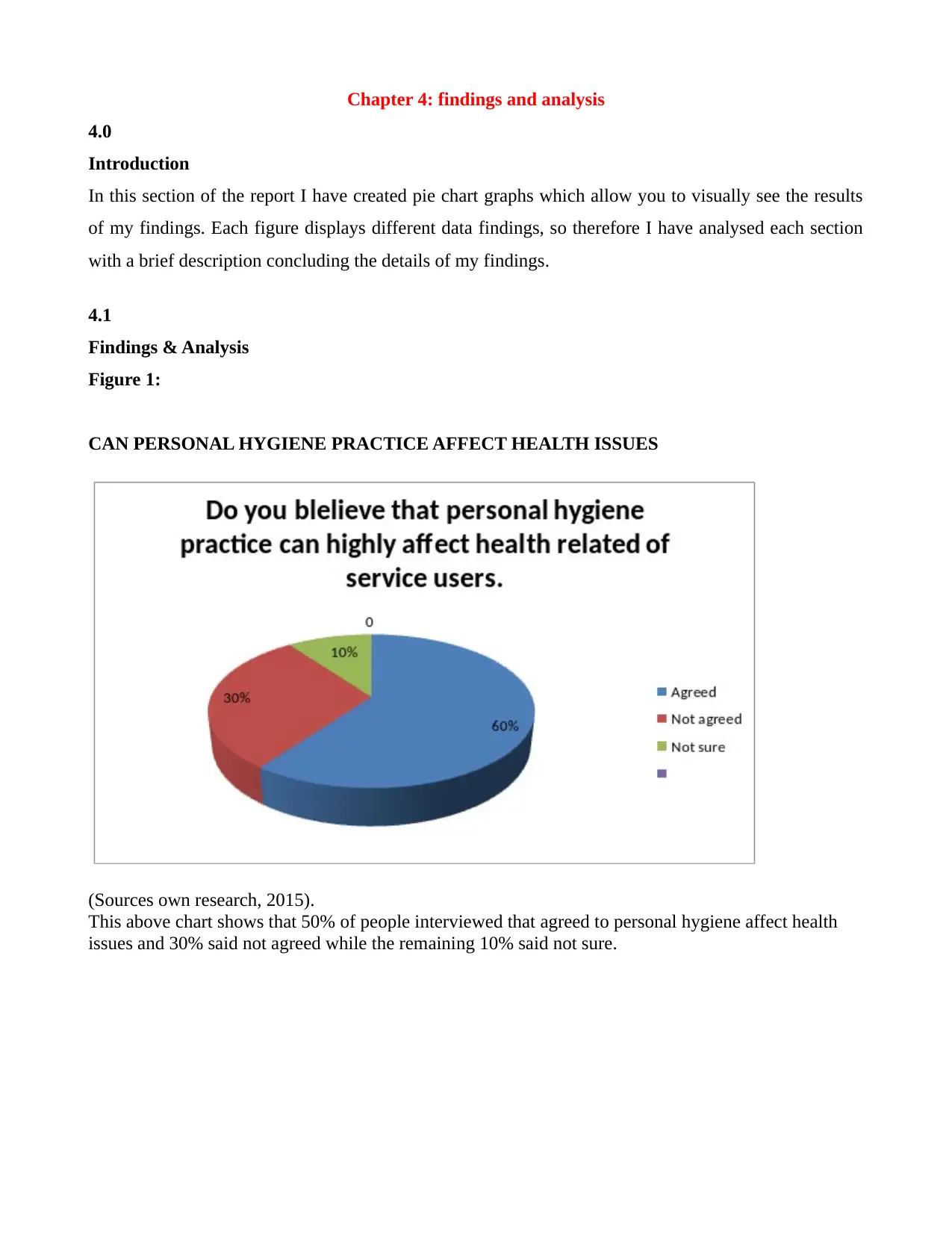
Chapter 4: findings and analysis
4.0
Introduction
In this section of the report I have created pie chart graphs which allow you to visually see the results
of my findings. Each figure displays different data findings, so therefore I have analysed each section
with a brief description concluding the details of my findings.
4.1
Findings & Analysis
Figure 1:
CAN PERSONAL HYGIENE PRACTICE AFFECT HEALTH ISSUES
(Sources own research, 2015).
This above chart shows that 50% of people interviewed that agreed to personal hygiene affect health
issues and 30% said not agreed while the remaining 10% said not sure.
4.0
Introduction
In this section of the report I have created pie chart graphs which allow you to visually see the results
of my findings. Each figure displays different data findings, so therefore I have analysed each section
with a brief description concluding the details of my findings.
4.1
Findings & Analysis
Figure 1:
CAN PERSONAL HYGIENE PRACTICE AFFECT HEALTH ISSUES
(Sources own research, 2015).
This above chart shows that 50% of people interviewed that agreed to personal hygiene affect health
issues and 30% said not agreed while the remaining 10% said not sure.

Figure 2:
How disease can be spread
(Source own research, 2015)
The chart above shows 50% of people interviewed that said “cholera is the disease that can easily
spread if the cleanliness is not maintained” and 20% said “individuals can contact Hepatitis B through
fluids” and another 20% said “Dengue is also a contagious disease” while 10% said all of the above.
Figure : 3
Your feelings about important of personal hygiene with service users
How disease can be spread
(Source own research, 2015)
The chart above shows 50% of people interviewed that said “cholera is the disease that can easily
spread if the cleanliness is not maintained” and 20% said “individuals can contact Hepatitis B through
fluids” and another 20% said “Dengue is also a contagious disease” while 10% said all of the above.
Figure : 3
Your feelings about important of personal hygiene with service users
Secure Best Marks with AI Grader
Need help grading? Try our AI Grader for instant feedback on your assignments.
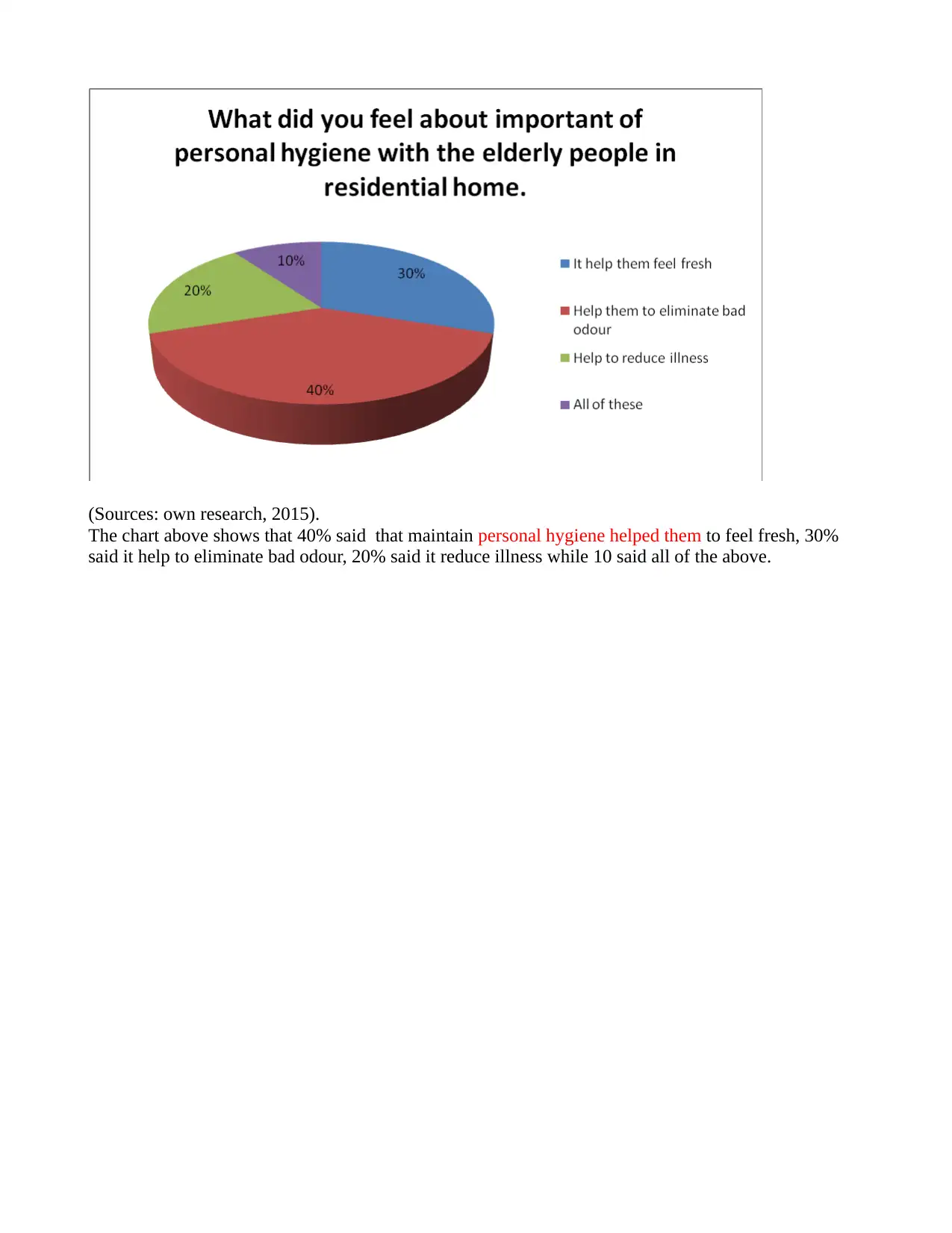
(Sources: own research, 2015).
The chart above shows that 40% said that maintain personal hygiene helped them to feel fresh, 30%
said it help to eliminate bad odour, 20% said it reduce illness while 10 said all of the above.
The chart above shows that 40% said that maintain personal hygiene helped them to feel fresh, 30%
said it help to eliminate bad odour, 20% said it reduce illness while 10 said all of the above.
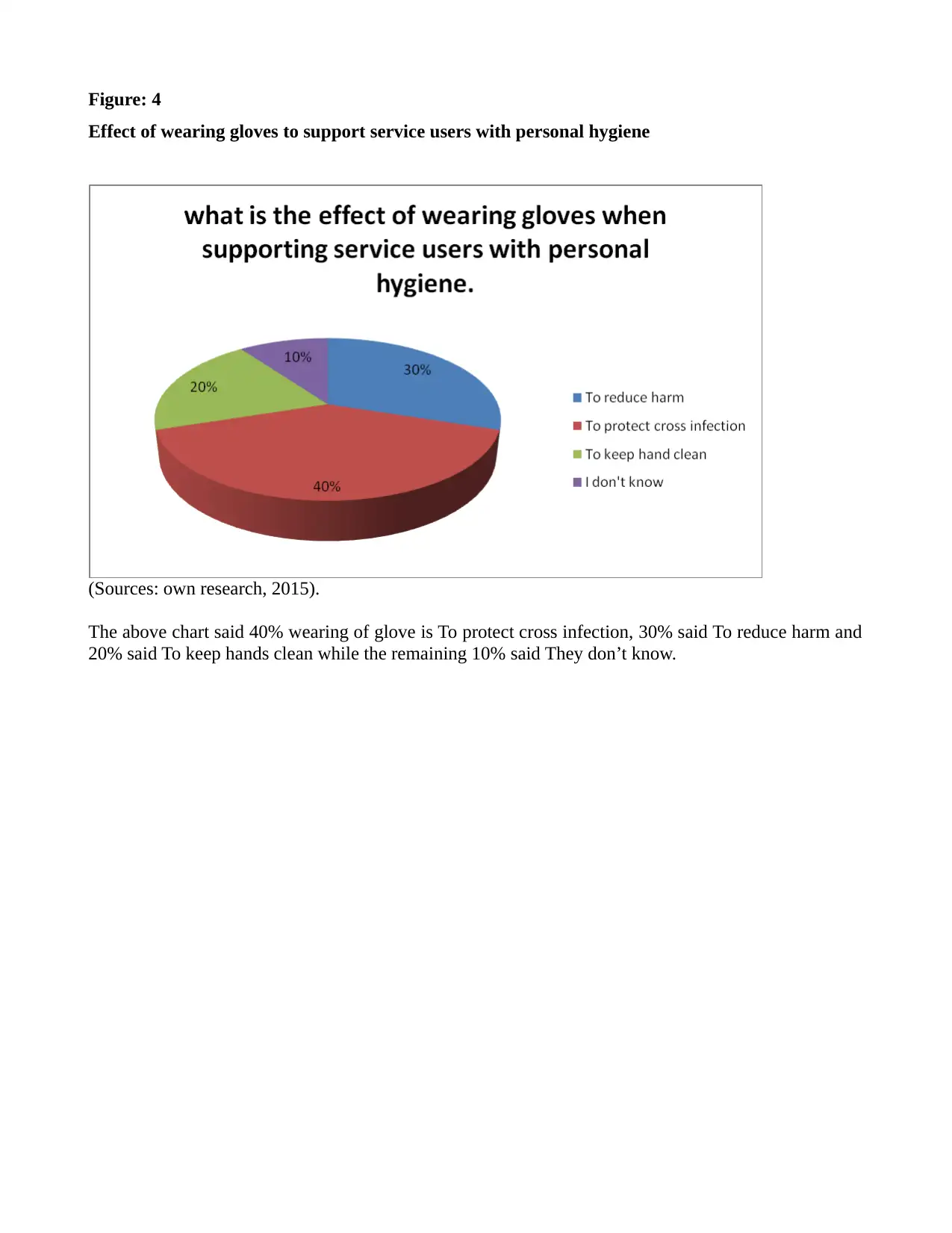
Figure: 4
Effect of wearing gloves to support service users with personal hygiene
(Sources: own research, 2015).
The above chart said 40% wearing of glove is To protect cross infection, 30% said To reduce harm and
20% said To keep hands clean while the remaining 10% said They don’t know.
Effect of wearing gloves to support service users with personal hygiene
(Sources: own research, 2015).
The above chart said 40% wearing of glove is To protect cross infection, 30% said To reduce harm and
20% said To keep hands clean while the remaining 10% said They don’t know.
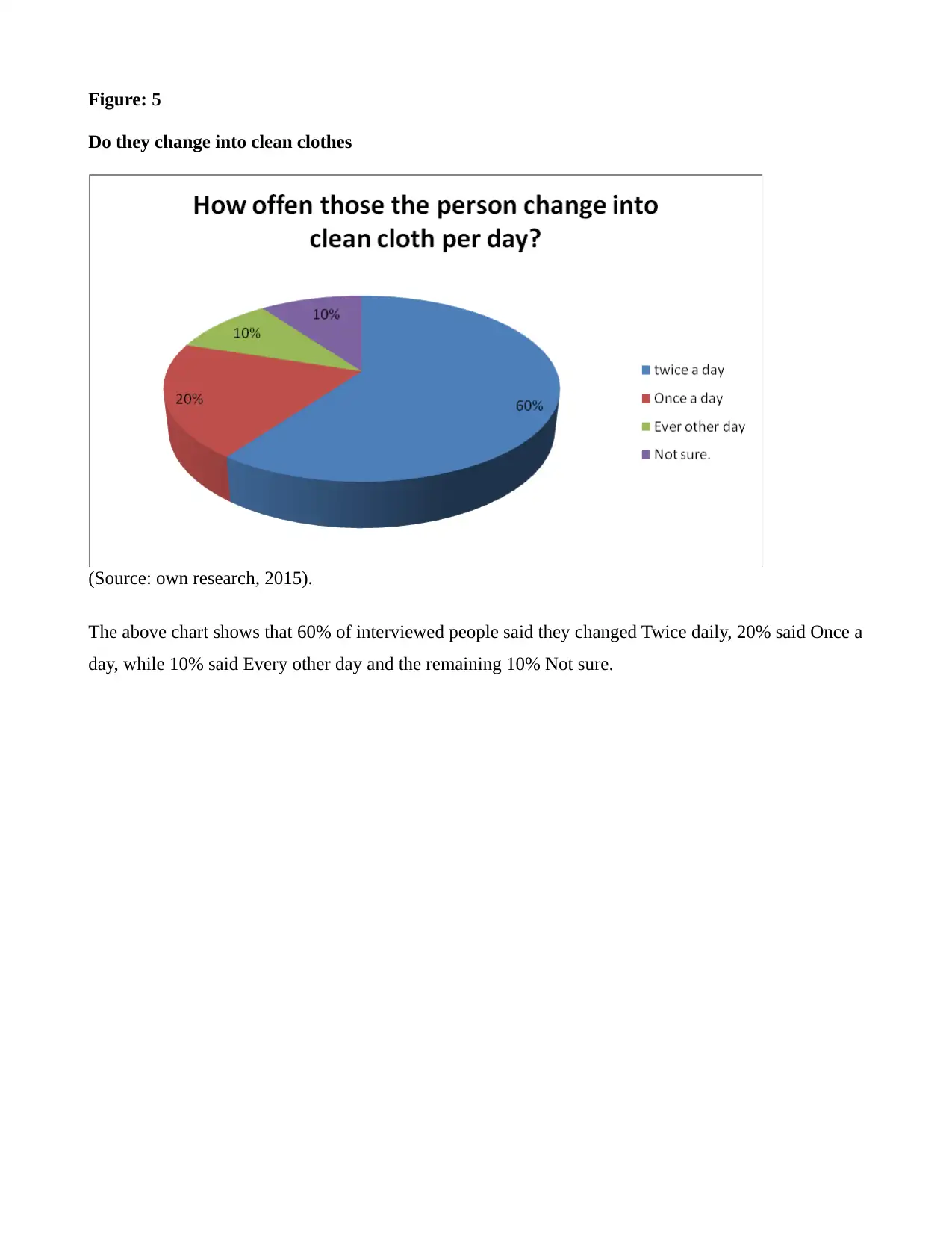
Figure: 5
Do they change into clean clothes
(Source: own research, 2015).
The above chart shows that 60% of interviewed people said they changed Twice daily, 20% said Once a
day, while 10% said Every other day and the remaining 10% Not sure.
Do they change into clean clothes
(Source: own research, 2015).
The above chart shows that 60% of interviewed people said they changed Twice daily, 20% said Once a
day, while 10% said Every other day and the remaining 10% Not sure.
Paraphrase This Document
Need a fresh take? Get an instant paraphrase of this document with our AI Paraphraser
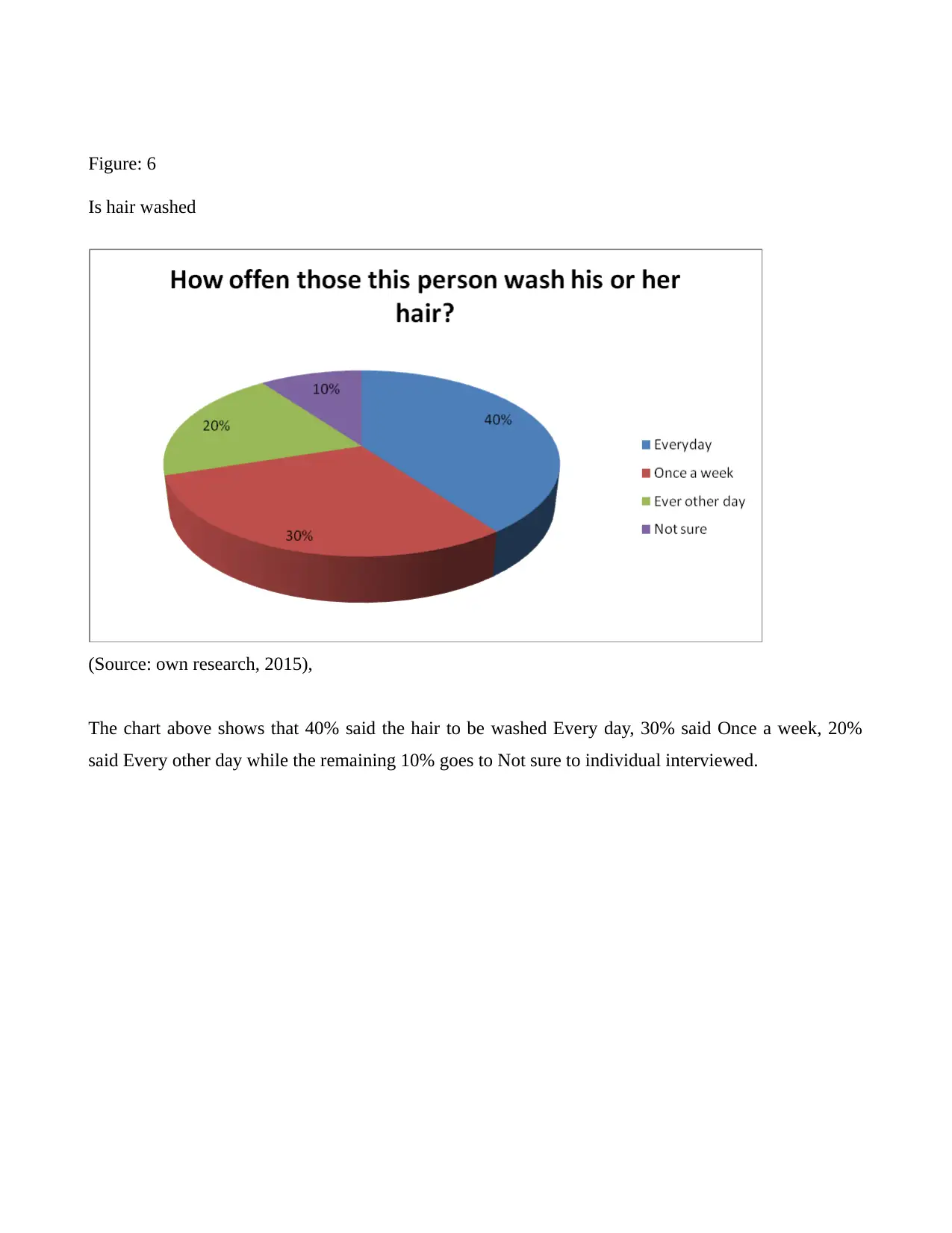
Figure: 6
Is hair washed
(Source: own research, 2015),
The chart above shows that 40% said the hair to be washed Every day, 30% said Once a week, 20%
said Every other day while the remaining 10% goes to Not sure to individual interviewed.
Is hair washed
(Source: own research, 2015),
The chart above shows that 40% said the hair to be washed Every day, 30% said Once a week, 20%
said Every other day while the remaining 10% goes to Not sure to individual interviewed.

Figure: 7
How does effort to perform personal hygiene considered
(Source: own research, 2015).The above chart shows 60% of people said Big effort, 30% No effort and
10% said Not Sure.
How does effort to perform personal hygiene considered
(Source: own research, 2015).The above chart shows 60% of people said Big effort, 30% No effort and
10% said Not Sure.
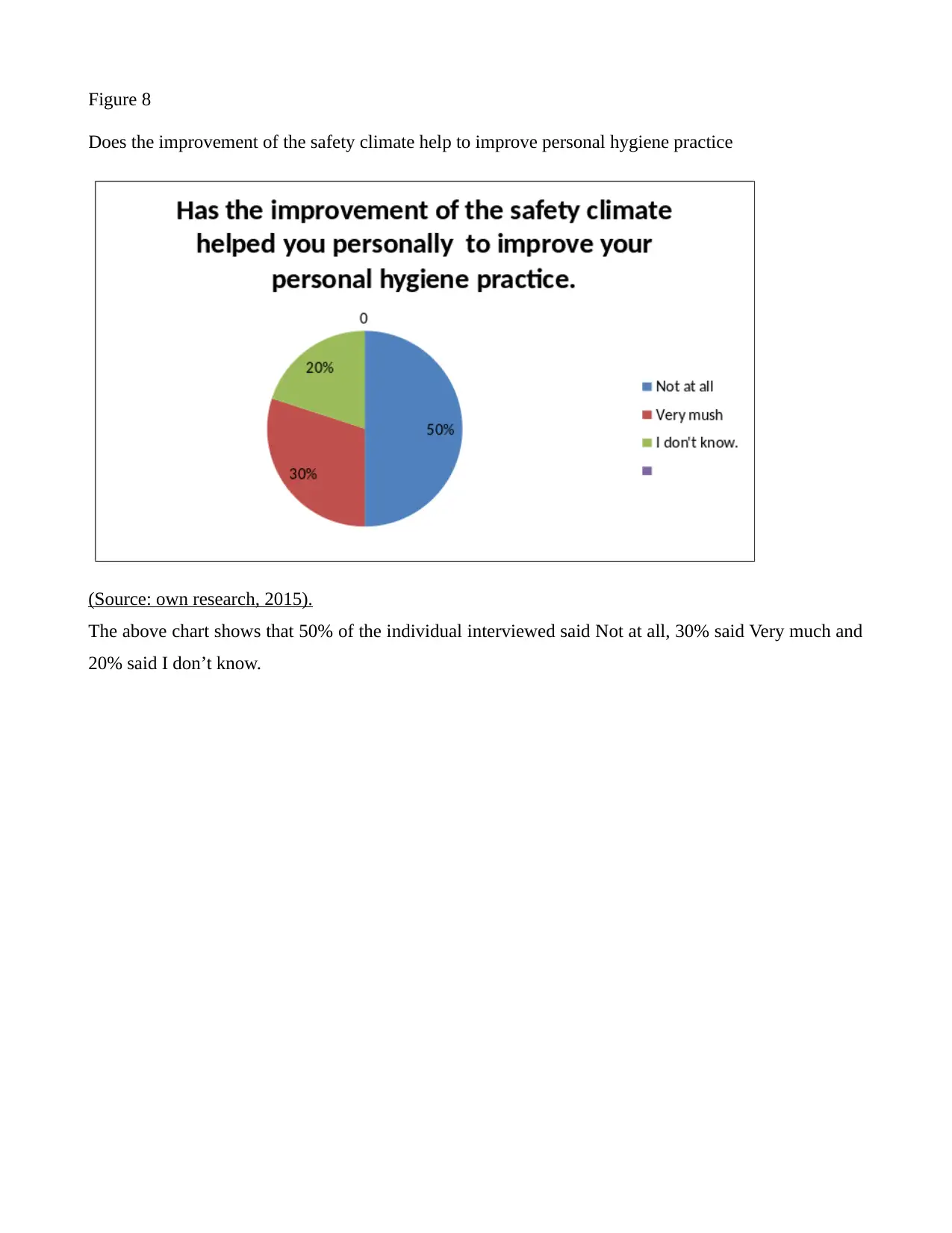
Figure 8
Does the improvement of the safety climate help to improve personal hygiene practice
(Source: own research, 2015).
The above chart shows that 50% of the individual interviewed said Not at all, 30% said Very much and
20% said I don’t know.
Does the improvement of the safety climate help to improve personal hygiene practice
(Source: own research, 2015).
The above chart shows that 50% of the individual interviewed said Not at all, 30% said Very much and
20% said I don’t know.
Secure Best Marks with AI Grader
Need help grading? Try our AI Grader for instant feedback on your assignments.
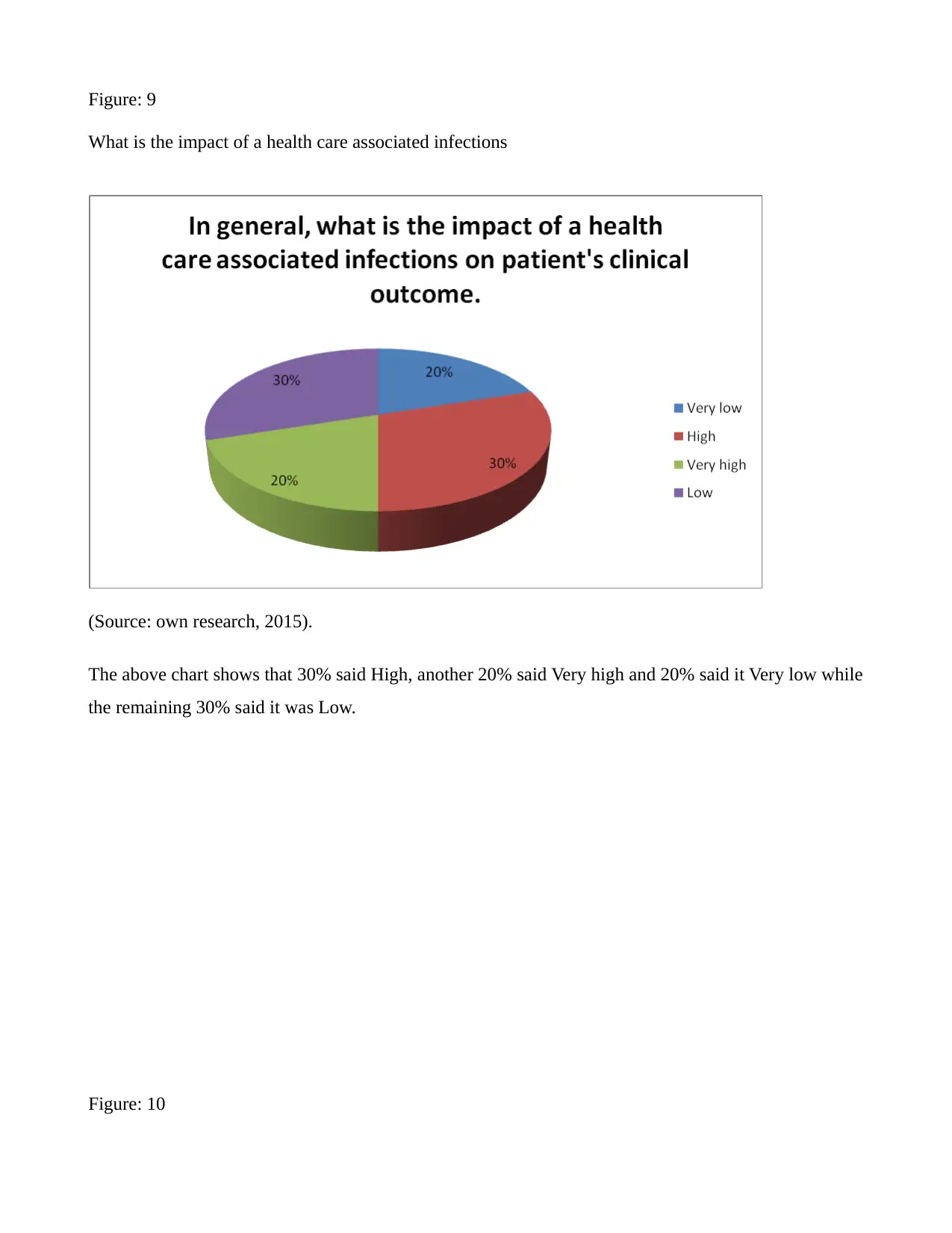
Figure: 9
What is the impact of a health care associated infections
(Source: own research, 2015).
The above chart shows that 30% said High, another 20% said Very high and 20% said it Very low while
the remaining 30% said it was Low.
Figure: 10
What is the impact of a health care associated infections
(Source: own research, 2015).
The above chart shows that 30% said High, another 20% said Very high and 20% said it Very low while
the remaining 30% said it was Low.
Figure: 10
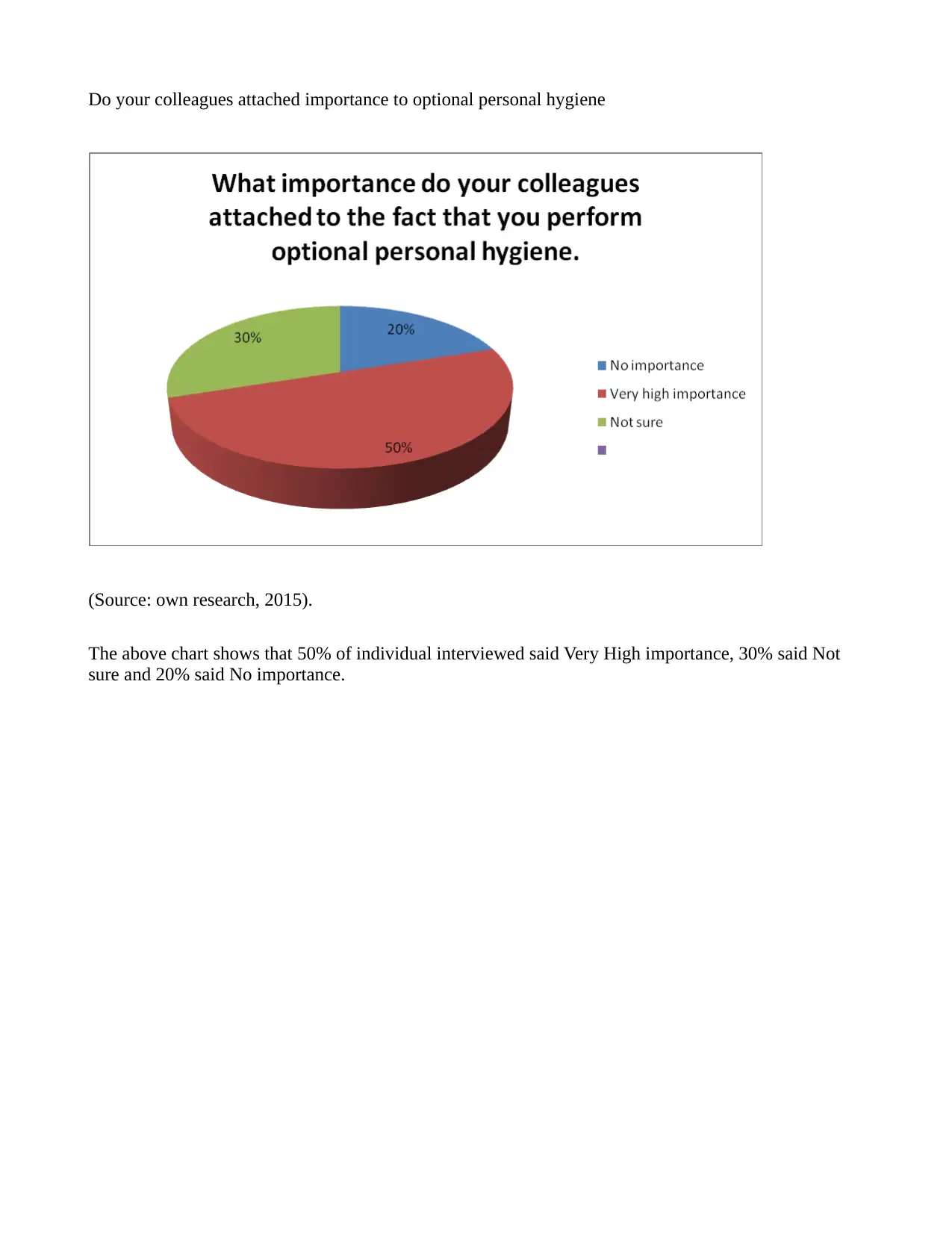
Do your colleagues attached importance to optional personal hygiene
(Source: own research, 2015).
The above chart shows that 50% of individual interviewed said Very High importance, 30% said Not
sure and 20% said No importance.
(Source: own research, 2015).
The above chart shows that 50% of individual interviewed said Very High importance, 30% said Not
sure and 20% said No importance.
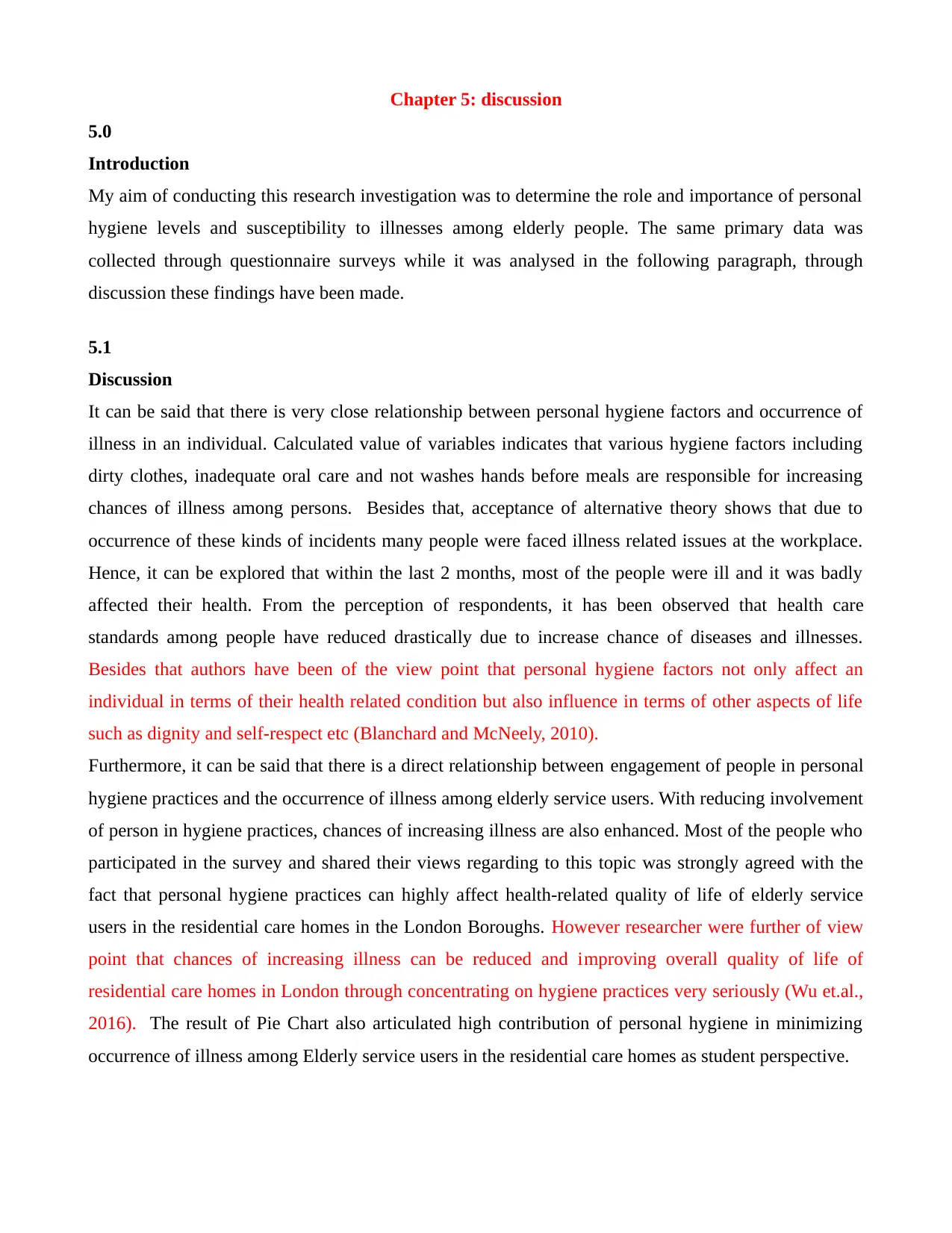
Chapter 5: discussion
5.0
Introduction
My aim of conducting this research investigation was to determine the role and importance of personal
hygiene levels and susceptibility to illnesses among elderly people. The same primary data was
collected through questionnaire surveys while it was analysed in the following paragraph, through
discussion these findings have been made.
5.1
Discussion
It can be said that there is very close relationship between personal hygiene factors and occurrence of
illness in an individual. Calculated value of variables indicates that various hygiene factors including
dirty clothes, inadequate oral care and not washes hands before meals are responsible for increasing
chances of illness among persons. Besides that, acceptance of alternative theory shows that due to
occurrence of these kinds of incidents many people were faced illness related issues at the workplace.
Hence, it can be explored that within the last 2 months, most of the people were ill and it was badly
affected their health. From the perception of respondents, it has been observed that health care
standards among people have reduced drastically due to increase chance of diseases and illnesses.
Besides that authors have been of the view point that personal hygiene factors not only affect an
individual in terms of their health related condition but also influence in terms of other aspects of life
such as dignity and self-respect etc (Blanchard and McNeely, 2010).
Furthermore, it can be said that there is a direct relationship between engagement of people in personal
hygiene practices and the occurrence of illness among elderly service users. With reducing involvement
of person in hygiene practices, chances of increasing illness are also enhanced. Most of the people who
participated in the survey and shared their views regarding to this topic was strongly agreed with the
fact that personal hygiene practices can highly affect health-related quality of life of elderly service
users in the residential care homes in the London Boroughs. However researcher were further of view
point that chances of increasing illness can be reduced and improving overall quality of life of
residential care homes in London through concentrating on hygiene practices very seriously (Wu et.al.,
2016). The result of Pie Chart also articulated high contribution of personal hygiene in minimizing
occurrence of illness among Elderly service users in the residential care homes as student perspective.
5.0
Introduction
My aim of conducting this research investigation was to determine the role and importance of personal
hygiene levels and susceptibility to illnesses among elderly people. The same primary data was
collected through questionnaire surveys while it was analysed in the following paragraph, through
discussion these findings have been made.
5.1
Discussion
It can be said that there is very close relationship between personal hygiene factors and occurrence of
illness in an individual. Calculated value of variables indicates that various hygiene factors including
dirty clothes, inadequate oral care and not washes hands before meals are responsible for increasing
chances of illness among persons. Besides that, acceptance of alternative theory shows that due to
occurrence of these kinds of incidents many people were faced illness related issues at the workplace.
Hence, it can be explored that within the last 2 months, most of the people were ill and it was badly
affected their health. From the perception of respondents, it has been observed that health care
standards among people have reduced drastically due to increase chance of diseases and illnesses.
Besides that authors have been of the view point that personal hygiene factors not only affect an
individual in terms of their health related condition but also influence in terms of other aspects of life
such as dignity and self-respect etc (Blanchard and McNeely, 2010).
Furthermore, it can be said that there is a direct relationship between engagement of people in personal
hygiene practices and the occurrence of illness among elderly service users. With reducing involvement
of person in hygiene practices, chances of increasing illness are also enhanced. Most of the people who
participated in the survey and shared their views regarding to this topic was strongly agreed with the
fact that personal hygiene practices can highly affect health-related quality of life of elderly service
users in the residential care homes in the London Boroughs. However researcher were further of view
point that chances of increasing illness can be reduced and improving overall quality of life of
residential care homes in London through concentrating on hygiene practices very seriously (Wu et.al.,
2016). The result of Pie Chart also articulated high contribution of personal hygiene in minimizing
occurrence of illness among Elderly service users in the residential care homes as student perspective.
Paraphrase This Document
Need a fresh take? Get an instant paraphrase of this document with our AI Paraphraser
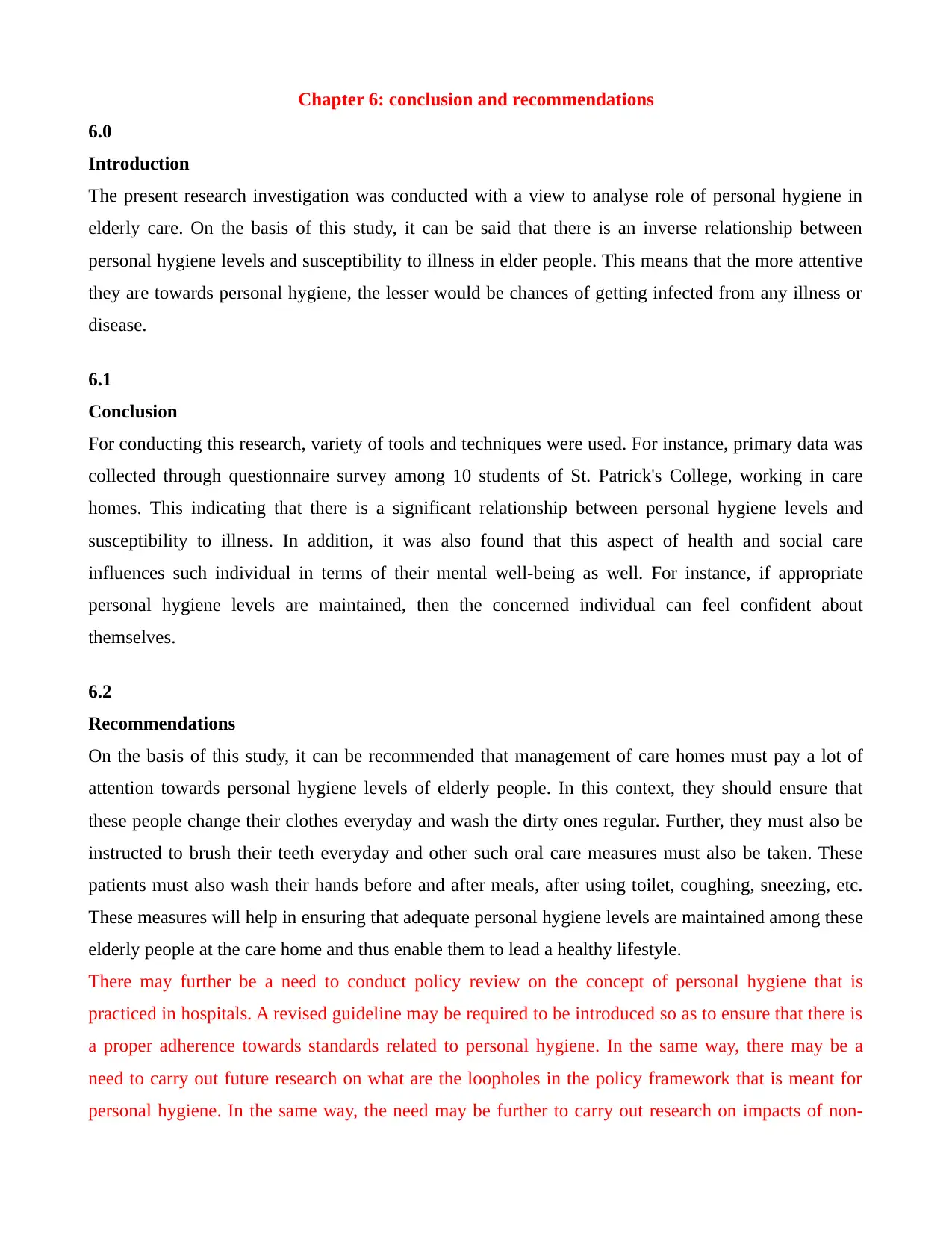
Chapter 6: conclusion and recommendations
6.0
Introduction
The present research investigation was conducted with a view to analyse role of personal hygiene in
elderly care. On the basis of this study, it can be said that there is an inverse relationship between
personal hygiene levels and susceptibility to illness in elder people. This means that the more attentive
they are towards personal hygiene, the lesser would be chances of getting infected from any illness or
disease.
6.1
Conclusion
For conducting this research, variety of tools and techniques were used. For instance, primary data was
collected through questionnaire survey among 10 students of St. Patrick's College, working in care
homes. This indicating that there is a significant relationship between personal hygiene levels and
susceptibility to illness. In addition, it was also found that this aspect of health and social care
influences such individual in terms of their mental well-being as well. For instance, if appropriate
personal hygiene levels are maintained, then the concerned individual can feel confident about
themselves.
6.2
Recommendations
On the basis of this study, it can be recommended that management of care homes must pay a lot of
attention towards personal hygiene levels of elderly people. In this context, they should ensure that
these people change their clothes everyday and wash the dirty ones regular. Further, they must also be
instructed to brush their teeth everyday and other such oral care measures must also be taken. These
patients must also wash their hands before and after meals, after using toilet, coughing, sneezing, etc.
These measures will help in ensuring that adequate personal hygiene levels are maintained among these
elderly people at the care home and thus enable them to lead a healthy lifestyle.
There may further be a need to conduct policy review on the concept of personal hygiene that is
practiced in hospitals. A revised guideline may be required to be introduced so as to ensure that there is
a proper adherence towards standards related to personal hygiene. In the same way, there may be a
need to carry out future research on what are the loopholes in the policy framework that is meant for
personal hygiene. In the same way, the need may be further to carry out research on impacts of non-
6.0
Introduction
The present research investigation was conducted with a view to analyse role of personal hygiene in
elderly care. On the basis of this study, it can be said that there is an inverse relationship between
personal hygiene levels and susceptibility to illness in elder people. This means that the more attentive
they are towards personal hygiene, the lesser would be chances of getting infected from any illness or
disease.
6.1
Conclusion
For conducting this research, variety of tools and techniques were used. For instance, primary data was
collected through questionnaire survey among 10 students of St. Patrick's College, working in care
homes. This indicating that there is a significant relationship between personal hygiene levels and
susceptibility to illness. In addition, it was also found that this aspect of health and social care
influences such individual in terms of their mental well-being as well. For instance, if appropriate
personal hygiene levels are maintained, then the concerned individual can feel confident about
themselves.
6.2
Recommendations
On the basis of this study, it can be recommended that management of care homes must pay a lot of
attention towards personal hygiene levels of elderly people. In this context, they should ensure that
these people change their clothes everyday and wash the dirty ones regular. Further, they must also be
instructed to brush their teeth everyday and other such oral care measures must also be taken. These
patients must also wash their hands before and after meals, after using toilet, coughing, sneezing, etc.
These measures will help in ensuring that adequate personal hygiene levels are maintained among these
elderly people at the care home and thus enable them to lead a healthy lifestyle.
There may further be a need to conduct policy review on the concept of personal hygiene that is
practiced in hospitals. A revised guideline may be required to be introduced so as to ensure that there is
a proper adherence towards standards related to personal hygiene. In the same way, there may be a
need to carry out future research on what are the loopholes in the policy framework that is meant for
personal hygiene. In the same way, the need may be further to carry out research on impacts of non-

maintenance of personal hygiene on patients.
=
=

REFERENCES
Books & Journals
Sjögren, P. and et. al., 2008. A systematic review of the preventive effect of oral hygiene on
pneumonia and respiratory tract infection in elderly people in hospitals and nursing homes: effect
estimates and methodological quality of randomized controlled trials. Journal of the American
Geriatrics Society. 56(11).pp. 2124-2130.
Stevenson, O., 2008. Neglect as an aspect of the mistreatment of elderly people: reflections on the
issues. The Journal of Adult Protection. 10(1). pp.24 – 35.
Saga, T., 2005. Care for the Elderly in Japan: Past, Present and Future, in Takao Takahashi. Taking Life
and Death Seriously - Bioethics from Japan. Emerald Group Publishing Limited.
Landi, F. and et. al., 2007. Physical activity prevented functional decline among frail community-living
elderly subjects in an international observational study. Journal of Clinical Epidemiology. 60(5).pp.
518-524.
Fialová, D. and et. al., 2005. Potentially inappropriate medication use among elderly home care
patients in Europe. Jama. 293(11).pp. 1348-1358.
Teeri, S., Leino-Kilpi, H. and Välimäki, M., 2006. Long-term nursing care of elderly people:
identifying ethically problematic experiences among patients, relatives and nurses in Finland.
Nursing ethics. 13(2).pp. 116-129.
Willis, S. L. and et. al., 2006. Long-term effects of cognitive training on everyday functional outcomes
in older adults. Jama. 296(23).pp. 2805-2814.
Soldato, M., 2007. Non malignant daily pain and risk of disability among older adults in home care in
Europe. Pain. 129(3).pp. 304-310.
Wilhelmson, K., 2005. Elderly people's perspectives on quality of life. Ageing and Society. 25(04).pp.
585-600.
Ekwall, A. K., Sivberg, B. and Hallberg, I. R., 2005. Loneliness as a predictor of quality of life among
older caregivers. Journal of advanced nursing. 49(1).pp. 23-32.
Evren, B. A., 2011. The association between socioeconomic status, oral hygiene practice, denture
stomatitis and oral status in elderly people living different residential homes. Archives of
gerontology and geriatrics. 53(3).pp. 252-257.
Maxwell, J., 2012. Qualitative Research Design: An Interactive Approach. SAGE.
Olsen, W., 2011. Data Collection: Key Databases and Methods in Social Research. SAGE.
.
Downey, H., Hamilton, K. and Catterall, M., 2007. Researching vulnerability: what about the
researcher? European Journal of Marketing. 41(7/8). pp.734 – 739.
Guercini, S., 2014. New qualitative research methodologies in management. Management Decision.
52(4). pp.662 – 674.
Munkejord, K., 2009. Methodological emotional reflexivity: The role of researcher emotions in
grounded theory research. Qualitative Research in Organizations and Management: An
International Journal. 4(2). pp.151 – 167.
Books & Journals
Sjögren, P. and et. al., 2008. A systematic review of the preventive effect of oral hygiene on
pneumonia and respiratory tract infection in elderly people in hospitals and nursing homes: effect
estimates and methodological quality of randomized controlled trials. Journal of the American
Geriatrics Society. 56(11).pp. 2124-2130.
Stevenson, O., 2008. Neglect as an aspect of the mistreatment of elderly people: reflections on the
issues. The Journal of Adult Protection. 10(1). pp.24 – 35.
Saga, T., 2005. Care for the Elderly in Japan: Past, Present and Future, in Takao Takahashi. Taking Life
and Death Seriously - Bioethics from Japan. Emerald Group Publishing Limited.
Landi, F. and et. al., 2007. Physical activity prevented functional decline among frail community-living
elderly subjects in an international observational study. Journal of Clinical Epidemiology. 60(5).pp.
518-524.
Fialová, D. and et. al., 2005. Potentially inappropriate medication use among elderly home care
patients in Europe. Jama. 293(11).pp. 1348-1358.
Teeri, S., Leino-Kilpi, H. and Välimäki, M., 2006. Long-term nursing care of elderly people:
identifying ethically problematic experiences among patients, relatives and nurses in Finland.
Nursing ethics. 13(2).pp. 116-129.
Willis, S. L. and et. al., 2006. Long-term effects of cognitive training on everyday functional outcomes
in older adults. Jama. 296(23).pp. 2805-2814.
Soldato, M., 2007. Non malignant daily pain and risk of disability among older adults in home care in
Europe. Pain. 129(3).pp. 304-310.
Wilhelmson, K., 2005. Elderly people's perspectives on quality of life. Ageing and Society. 25(04).pp.
585-600.
Ekwall, A. K., Sivberg, B. and Hallberg, I. R., 2005. Loneliness as a predictor of quality of life among
older caregivers. Journal of advanced nursing. 49(1).pp. 23-32.
Evren, B. A., 2011. The association between socioeconomic status, oral hygiene practice, denture
stomatitis and oral status in elderly people living different residential homes. Archives of
gerontology and geriatrics. 53(3).pp. 252-257.
Maxwell, J., 2012. Qualitative Research Design: An Interactive Approach. SAGE.
Olsen, W., 2011. Data Collection: Key Databases and Methods in Social Research. SAGE.
.
Downey, H., Hamilton, K. and Catterall, M., 2007. Researching vulnerability: what about the
researcher? European Journal of Marketing. 41(7/8). pp.734 – 739.
Guercini, S., 2014. New qualitative research methodologies in management. Management Decision.
52(4). pp.662 – 674.
Munkejord, K., 2009. Methodological emotional reflexivity: The role of researcher emotions in
grounded theory research. Qualitative Research in Organizations and Management: An
International Journal. 4(2). pp.151 – 167.
Secure Best Marks with AI Grader
Need help grading? Try our AI Grader for instant feedback on your assignments.
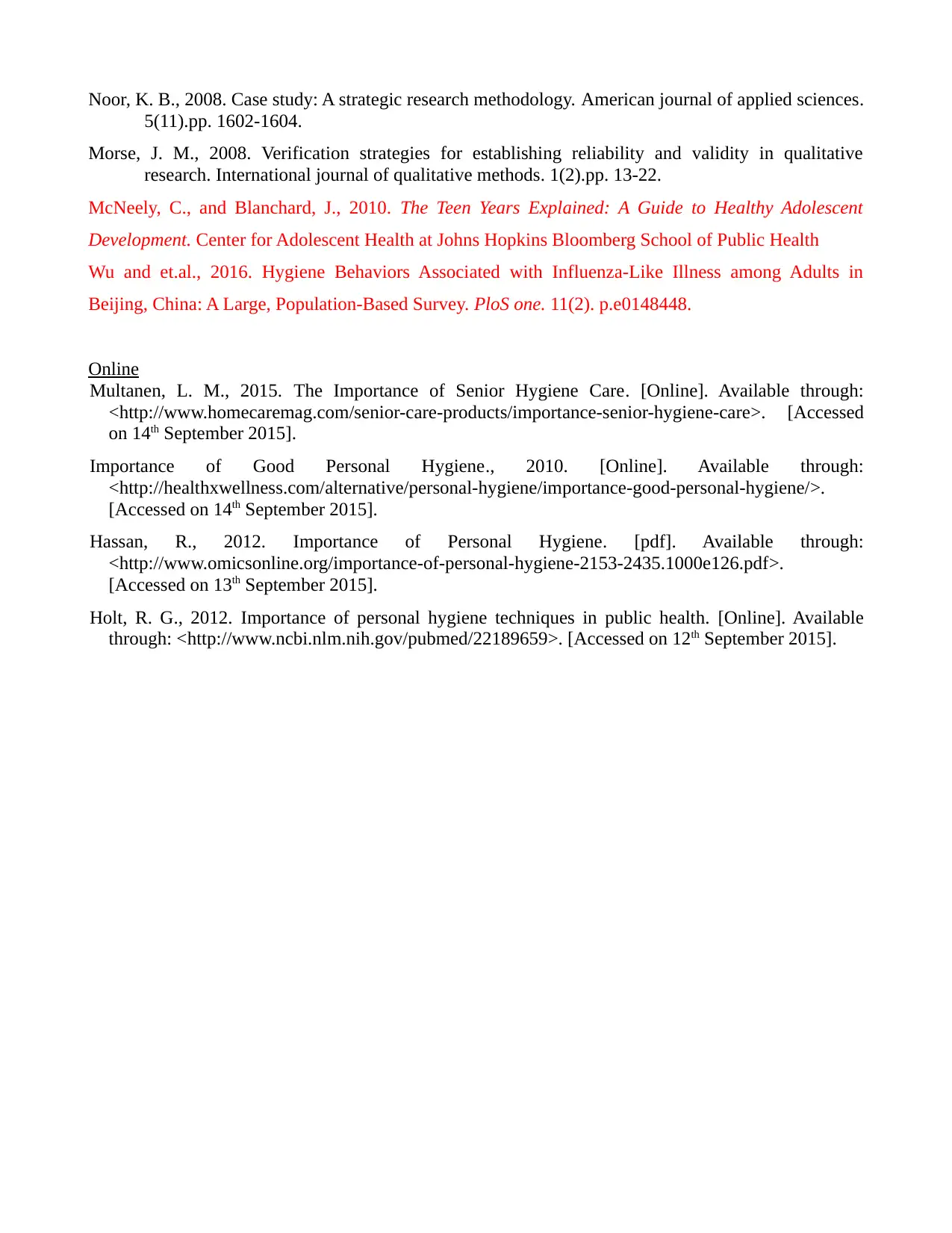
Noor, K. B., 2008. Case study: A strategic research methodology. American journal of applied sciences.
5(11).pp. 1602-1604.
Morse, J. M., 2008. Verification strategies for establishing reliability and validity in qualitative
research. International journal of qualitative methods. 1(2).pp. 13-22.
McNeely, C., and Blanchard, J., 2010. The Teen Years Explained: A Guide to Healthy Adolescent
Development. Center for Adolescent Health at Johns Hopkins Bloomberg School of Public Health
Wu and et.al., 2016. Hygiene Behaviors Associated with Influenza-Like Illness among Adults in
Beijing, China: A Large, Population-Based Survey. PloS one. 11(2). p.e0148448.
Online
Multanen, L. M., 2015. The Importance of Senior Hygiene Care. [Online]. Available through:
<http://www.homecaremag.com/senior-care-products/importance-senior-hygiene-care>. [Accessed
on 14th September 2015].
Importance of Good Personal Hygiene., 2010. [Online]. Available through:
<http://healthxwellness.com/alternative/personal-hygiene/importance-good-personal-hygiene/>.
[Accessed on 14th September 2015].
Hassan, R., 2012. Importance of Personal Hygiene. [pdf]. Available through:
<http://www.omicsonline.org/importance-of-personal-hygiene-2153-2435.1000e126.pdf>.
[Accessed on 13th September 2015].
Holt, R. G., 2012. Importance of personal hygiene techniques in public health. [Online]. Available
through: <http://www.ncbi.nlm.nih.gov/pubmed/22189659>. [Accessed on 12th September 2015].
5(11).pp. 1602-1604.
Morse, J. M., 2008. Verification strategies for establishing reliability and validity in qualitative
research. International journal of qualitative methods. 1(2).pp. 13-22.
McNeely, C., and Blanchard, J., 2010. The Teen Years Explained: A Guide to Healthy Adolescent
Development. Center for Adolescent Health at Johns Hopkins Bloomberg School of Public Health
Wu and et.al., 2016. Hygiene Behaviors Associated with Influenza-Like Illness among Adults in
Beijing, China: A Large, Population-Based Survey. PloS one. 11(2). p.e0148448.
Online
Multanen, L. M., 2015. The Importance of Senior Hygiene Care. [Online]. Available through:
<http://www.homecaremag.com/senior-care-products/importance-senior-hygiene-care>. [Accessed
on 14th September 2015].
Importance of Good Personal Hygiene., 2010. [Online]. Available through:
<http://healthxwellness.com/alternative/personal-hygiene/importance-good-personal-hygiene/>.
[Accessed on 14th September 2015].
Hassan, R., 2012. Importance of Personal Hygiene. [pdf]. Available through:
<http://www.omicsonline.org/importance-of-personal-hygiene-2153-2435.1000e126.pdf>.
[Accessed on 13th September 2015].
Holt, R. G., 2012. Importance of personal hygiene techniques in public health. [Online]. Available
through: <http://www.ncbi.nlm.nih.gov/pubmed/22189659>. [Accessed on 12th September 2015].
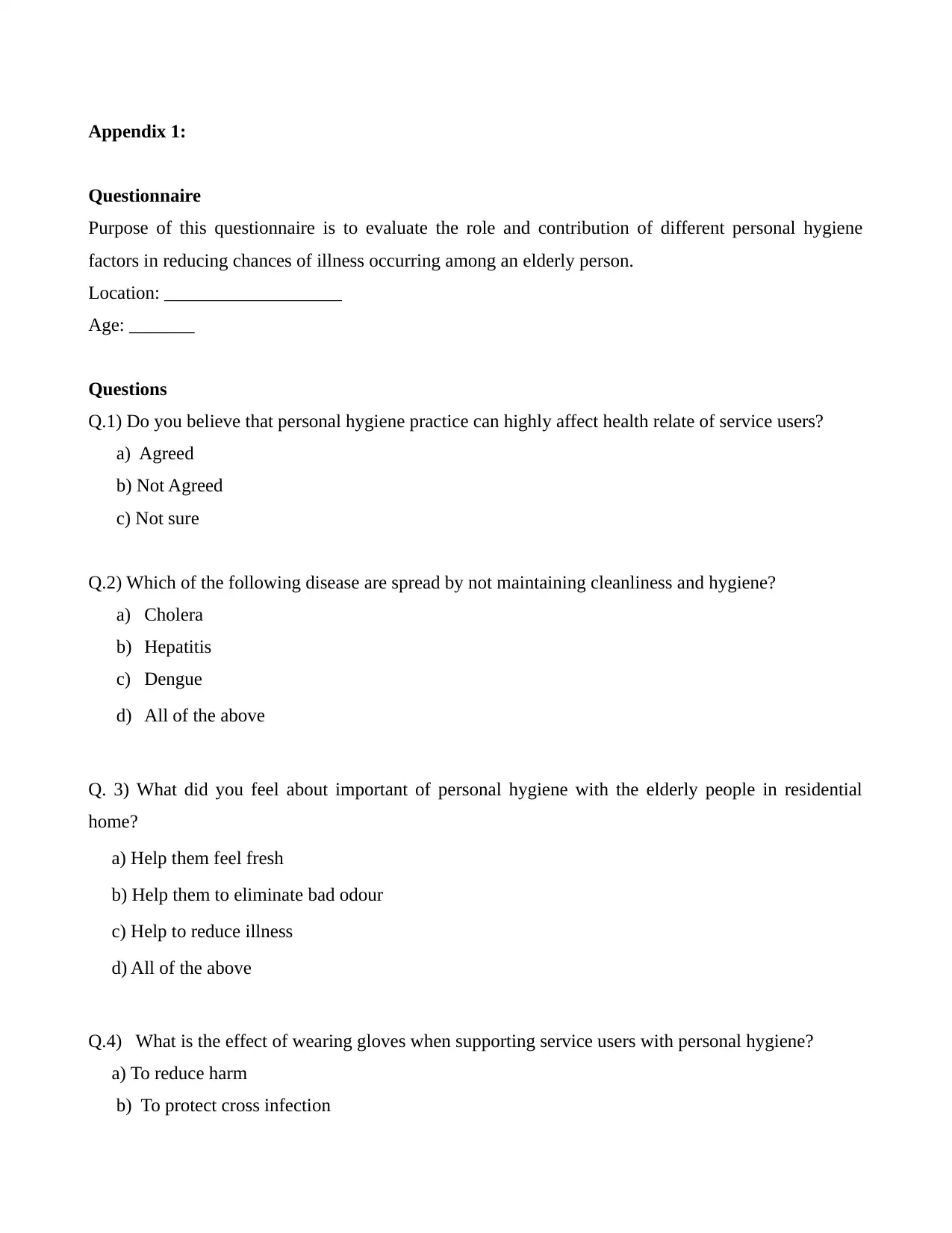
Appendix 1:
Questionnaire
Purpose of this questionnaire is to evaluate the role and contribution of different personal hygiene
factors in reducing chances of illness occurring among an elderly person.
Location: ___________________
Age: _______
Questions
Q.1) Do you believe that personal hygiene practice can highly affect health relate of service users?
a) Agreed
b) Not Agreed
c) Not sure
Q.2) Which of the following disease are spread by not maintaining cleanliness and hygiene?
a) Cholera
b) Hepatitis
c) Dengue
d) All of the above
Q. 3) What did you feel about important of personal hygiene with the elderly people in residential
home?
a) Help them feel fresh
b) Help them to eliminate bad odour
c) Help to reduce illness
d) All of the above
Q.4) What is the effect of wearing gloves when supporting service users with personal hygiene?
a) To reduce harm
b) To protect cross infection
Questionnaire
Purpose of this questionnaire is to evaluate the role and contribution of different personal hygiene
factors in reducing chances of illness occurring among an elderly person.
Location: ___________________
Age: _______
Questions
Q.1) Do you believe that personal hygiene practice can highly affect health relate of service users?
a) Agreed
b) Not Agreed
c) Not sure
Q.2) Which of the following disease are spread by not maintaining cleanliness and hygiene?
a) Cholera
b) Hepatitis
c) Dengue
d) All of the above
Q. 3) What did you feel about important of personal hygiene with the elderly people in residential
home?
a) Help them feel fresh
b) Help them to eliminate bad odour
c) Help to reduce illness
d) All of the above
Q.4) What is the effect of wearing gloves when supporting service users with personal hygiene?
a) To reduce harm
b) To protect cross infection

c) To keep hands clean
d) I don’t know
Q.5) How often those person change into clean clothes per day?
a) Twice a day
b) Once a day
c) Every other day
d) Not sure
Q.6) How often does these person wash his/her hair?
a) Everyday
b) Once a week
c) Every other day
d) Not sure
Q.7) How do you considered the effort required by you to perform personal hygiene when caring for
individual?
a) No effort
b) Big effort
c) Not sure
Q.8) Has the improvement of the safety climate helped you personally to improve personal hygiene
practice?
a) Not at all
b) Very much
c) I don’t know
Q.9) In general, what is the impact of a healthcare associated infections on patient’s clinical outcome?
a) Very low
b) High
c)Very high and d) Low
d) I don’t know
Q.5) How often those person change into clean clothes per day?
a) Twice a day
b) Once a day
c) Every other day
d) Not sure
Q.6) How often does these person wash his/her hair?
a) Everyday
b) Once a week
c) Every other day
d) Not sure
Q.7) How do you considered the effort required by you to perform personal hygiene when caring for
individual?
a) No effort
b) Big effort
c) Not sure
Q.8) Has the improvement of the safety climate helped you personally to improve personal hygiene
practice?
a) Not at all
b) Very much
c) I don’t know
Q.9) In general, what is the impact of a healthcare associated infections on patient’s clinical outcome?
a) Very low
b) High
c)Very high and d) Low
Paraphrase This Document
Need a fresh take? Get an instant paraphrase of this document with our AI Paraphraser
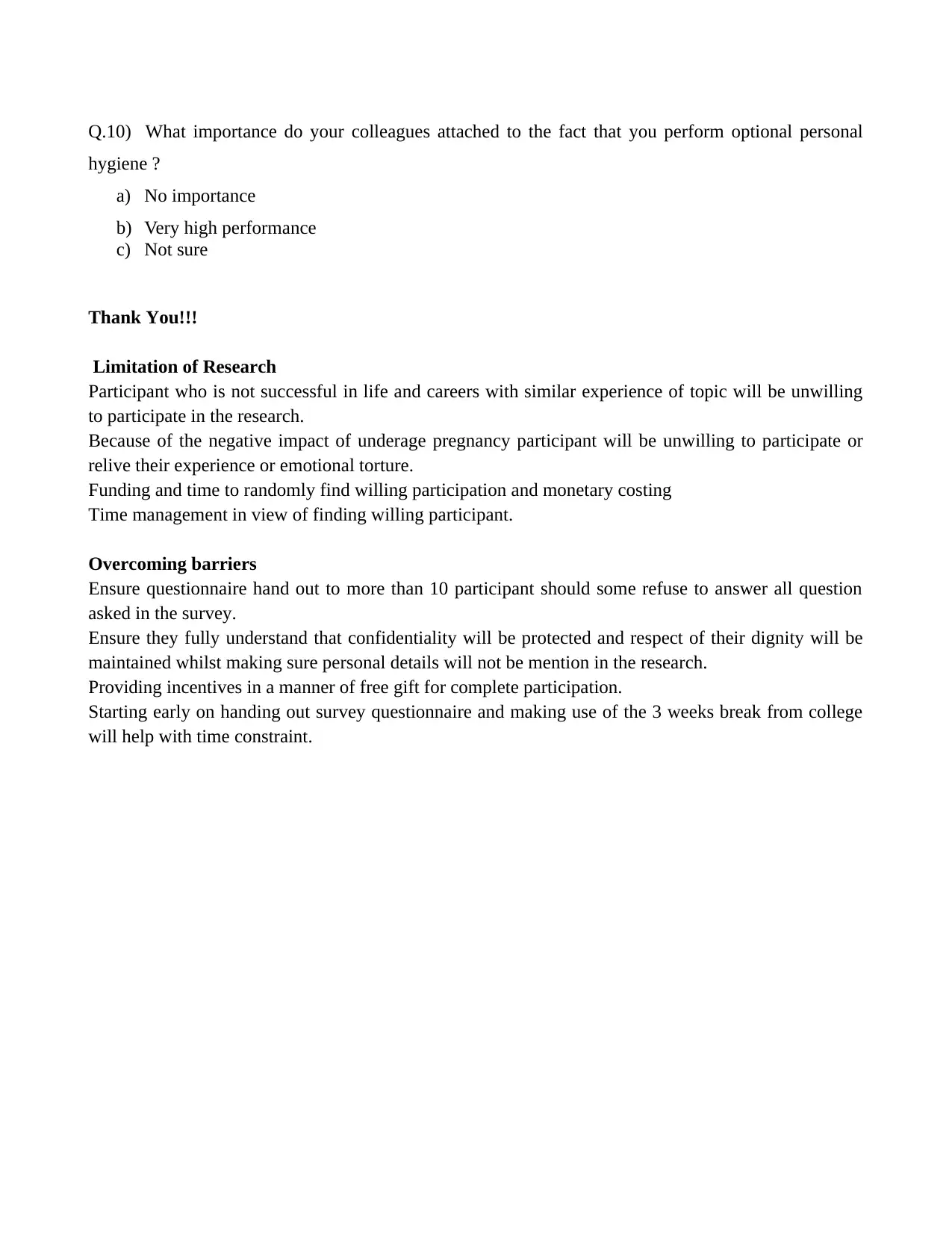
Q.10) What importance do your colleagues attached to the fact that you perform optional personal
hygiene ?
a) No importance
b) Very high performance
c) Not sure
Thank You!!!
Limitation of Research
Participant who is not successful in life and careers with similar experience of topic will be unwilling
to participate in the research.
Because of the negative impact of underage pregnancy participant will be unwilling to participate or
relive their experience or emotional torture.
Funding and time to randomly find willing participation and monetary costing
Time management in view of finding willing participant.
Overcoming barriers
Ensure questionnaire hand out to more than 10 participant should some refuse to answer all question
asked in the survey.
Ensure they fully understand that confidentiality will be protected and respect of their dignity will be
maintained whilst making sure personal details will not be mention in the research.
Providing incentives in a manner of free gift for complete participation.
Starting early on handing out survey questionnaire and making use of the 3 weeks break from college
will help with time constraint.
hygiene ?
a) No importance
b) Very high performance
c) Not sure
Thank You!!!
Limitation of Research
Participant who is not successful in life and careers with similar experience of topic will be unwilling
to participate in the research.
Because of the negative impact of underage pregnancy participant will be unwilling to participate or
relive their experience or emotional torture.
Funding and time to randomly find willing participation and monetary costing
Time management in view of finding willing participant.
Overcoming barriers
Ensure questionnaire hand out to more than 10 participant should some refuse to answer all question
asked in the survey.
Ensure they fully understand that confidentiality will be protected and respect of their dignity will be
maintained whilst making sure personal details will not be mention in the research.
Providing incentives in a manner of free gift for complete participation.
Starting early on handing out survey questionnaire and making use of the 3 weeks break from college
will help with time constraint.

Appendix 2: Consent to Participate in the study
Participant Information Letter
Date: 23rd September 2015
I am a student studying health and social care at St Patrick College. I have decided to conduct this
research investigation in order to determine role played by different personal hygiene factors in
reducing the chances of an illness occurring in an elderly individual. Herein I aim at evaluating the
views and perceptions of students regarding the concept working in the health care industry. Objective
of this study is to identify if there is any relationship between personal hygiene factors and occurrences
of illness in elderly people. Further it will also evaluate different personal hygiene factors that are not
related to health. Here I invite you to participate in this research, as you have been working in this
sector.
Your participation to this study is completely voluntary, meaning that if you do not wish to participate,
you are free to do so. But your contribution to this research by participating in it would be highly
valued. Precautions will be taken to ensure that information collected through this research are kept
confidential. In addition, your personal information such as your name, age, etc. will also be kept safe.
Provisions of the Data Protection Act would be taken into consideration.
I agree to participate in the research stated above.
_________________________ _____________ ______________
Name of participant Date Signature
_________________________ _____________ ______________
Name of researcher Date Signature
Contact Information
If you need to interact with me regarding any aspect of this research or the questionnaire, then please
feel free to do so. You can contact me through my email: XYZ@gmail.com for any aspect related to the
study or with any query.
Participant Information Letter
Date: 23rd September 2015
I am a student studying health and social care at St Patrick College. I have decided to conduct this
research investigation in order to determine role played by different personal hygiene factors in
reducing the chances of an illness occurring in an elderly individual. Herein I aim at evaluating the
views and perceptions of students regarding the concept working in the health care industry. Objective
of this study is to identify if there is any relationship between personal hygiene factors and occurrences
of illness in elderly people. Further it will also evaluate different personal hygiene factors that are not
related to health. Here I invite you to participate in this research, as you have been working in this
sector.
Your participation to this study is completely voluntary, meaning that if you do not wish to participate,
you are free to do so. But your contribution to this research by participating in it would be highly
valued. Precautions will be taken to ensure that information collected through this research are kept
confidential. In addition, your personal information such as your name, age, etc. will also be kept safe.
Provisions of the Data Protection Act would be taken into consideration.
I agree to participate in the research stated above.
_________________________ _____________ ______________
Name of participant Date Signature
_________________________ _____________ ______________
Name of researcher Date Signature
Contact Information
If you need to interact with me regarding any aspect of this research or the questionnaire, then please
feel free to do so. You can contact me through my email: XYZ@gmail.com for any aspect related to the
study or with any query.
1 out of 33
Your All-in-One AI-Powered Toolkit for Academic Success.
+13062052269
info@desklib.com
Available 24*7 on WhatsApp / Email
![[object Object]](/_next/static/media/star-bottom.7253800d.svg)
Unlock your academic potential
© 2024 | Zucol Services PVT LTD | All rights reserved.





